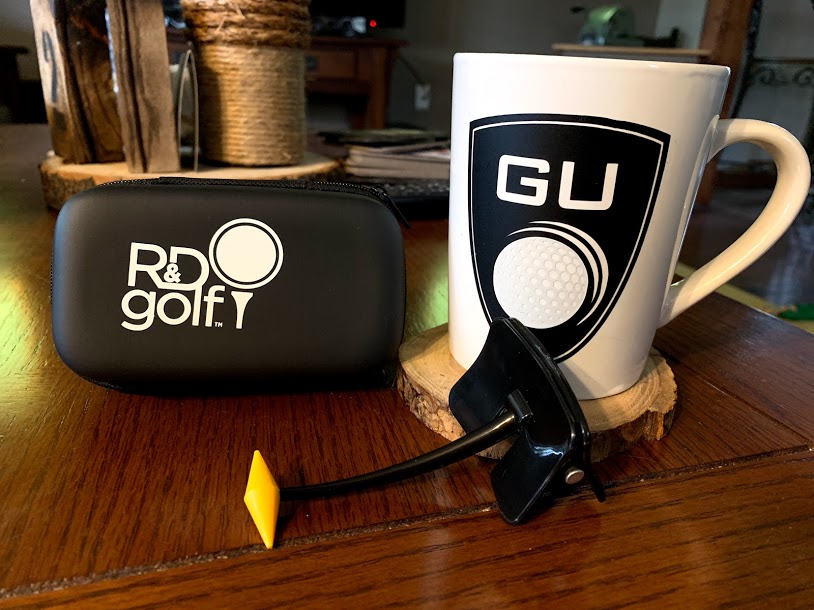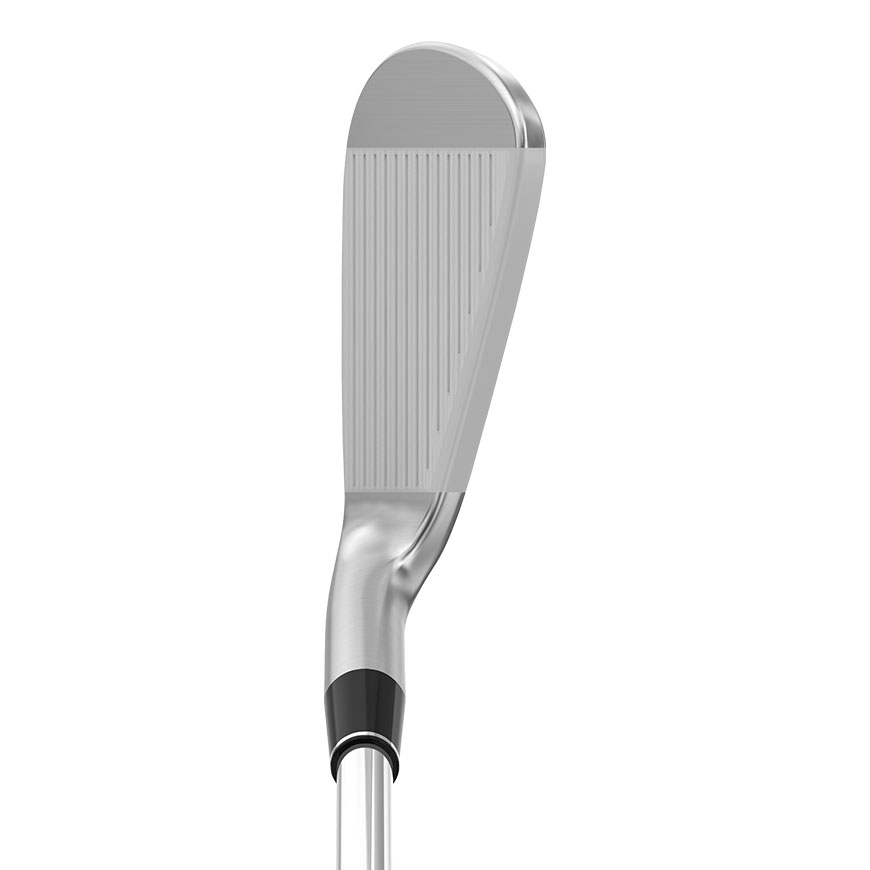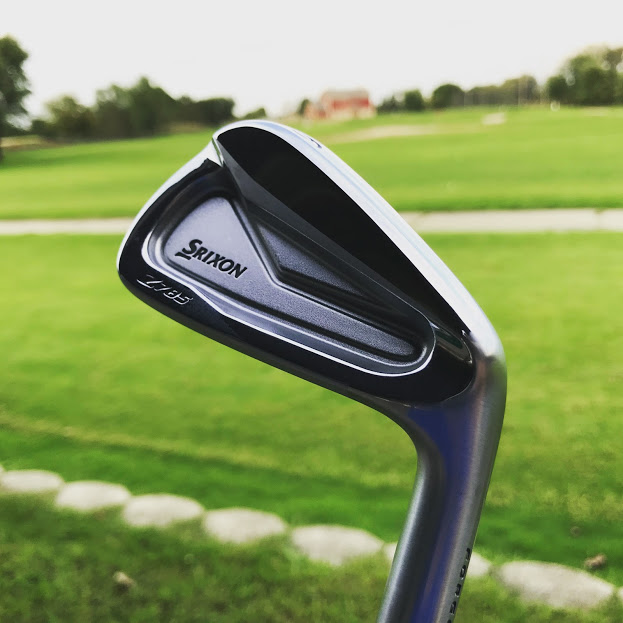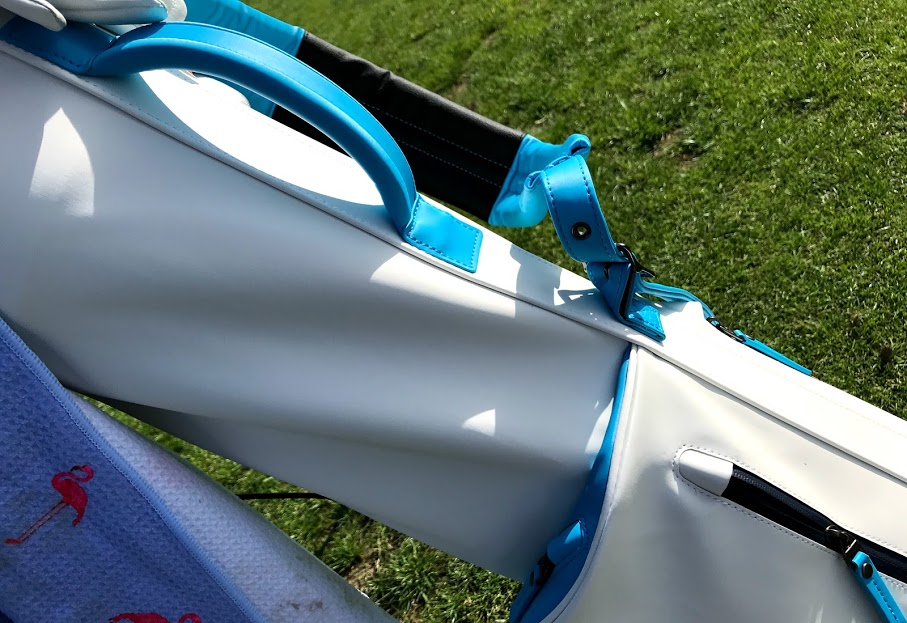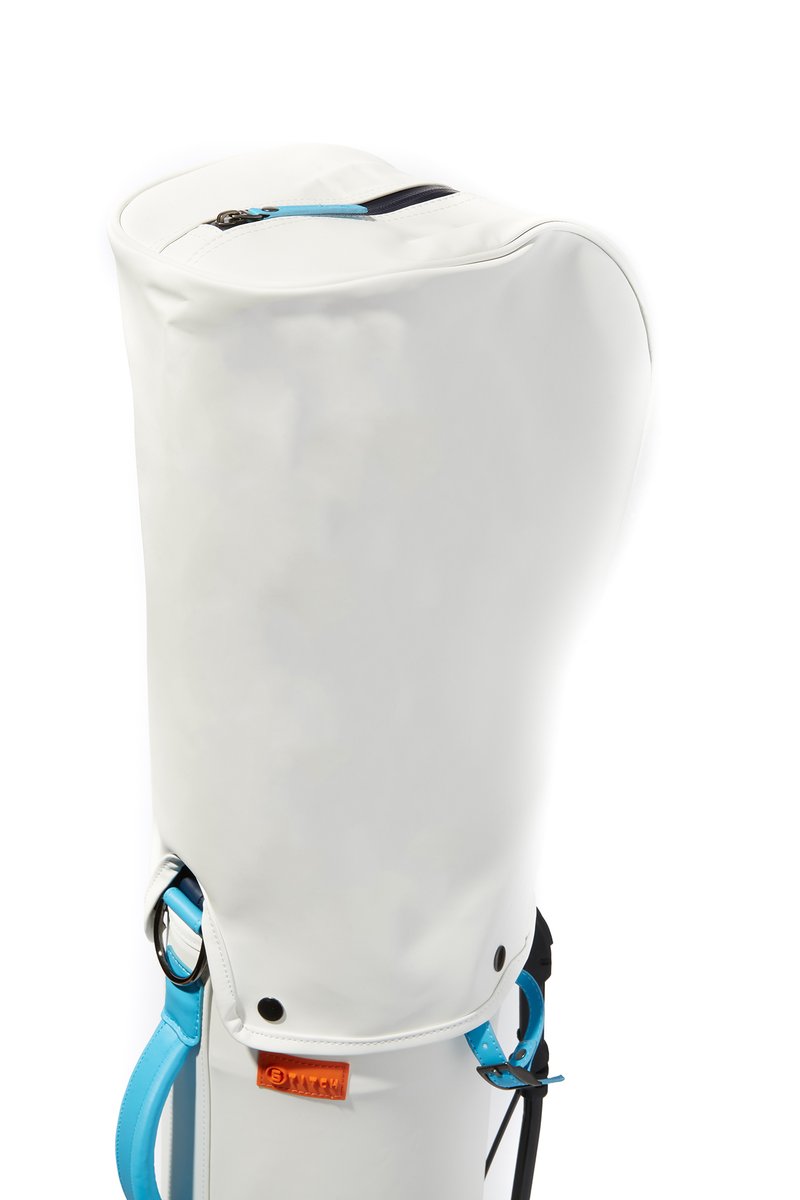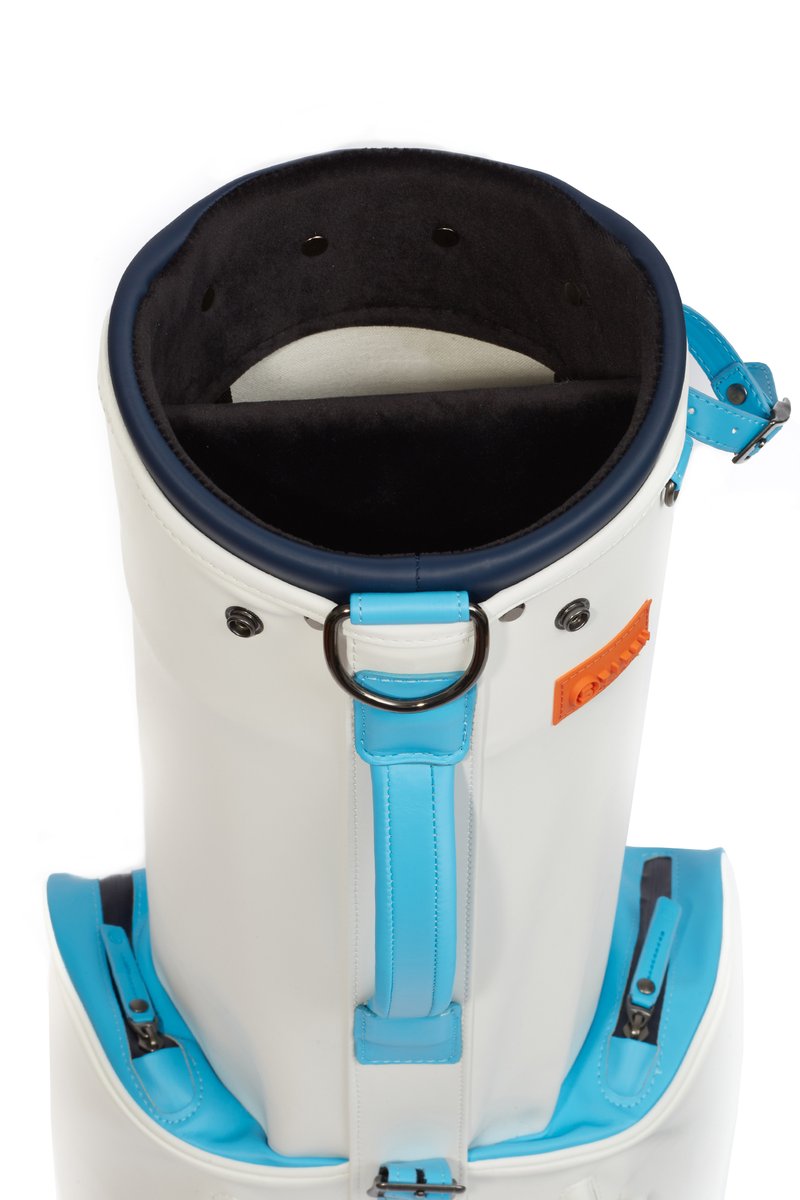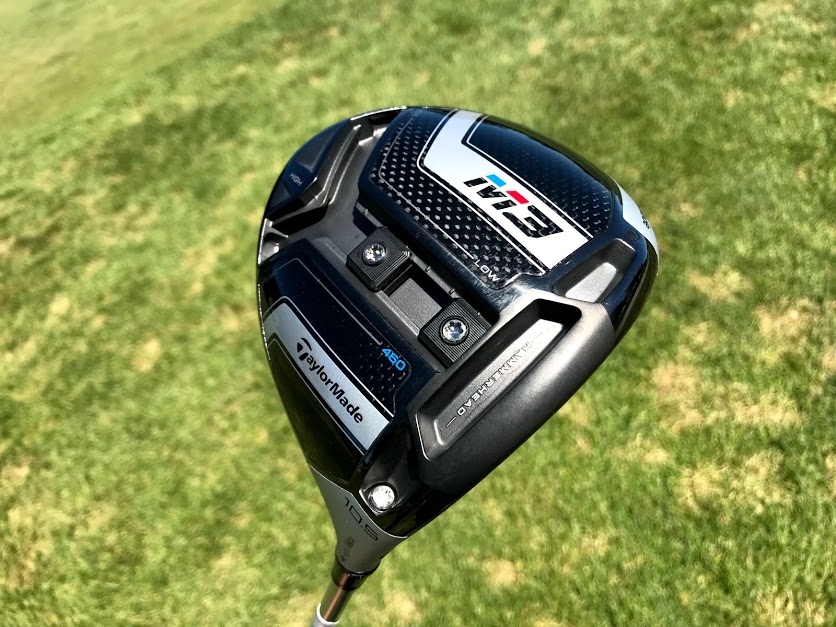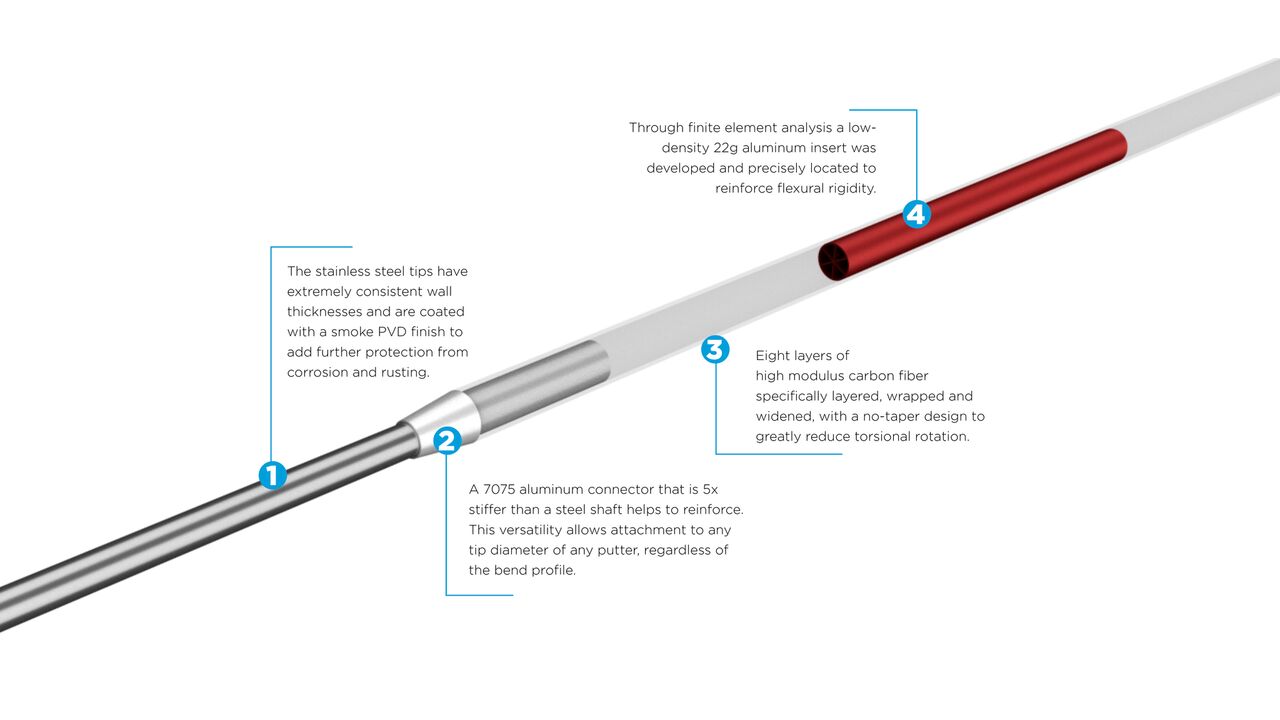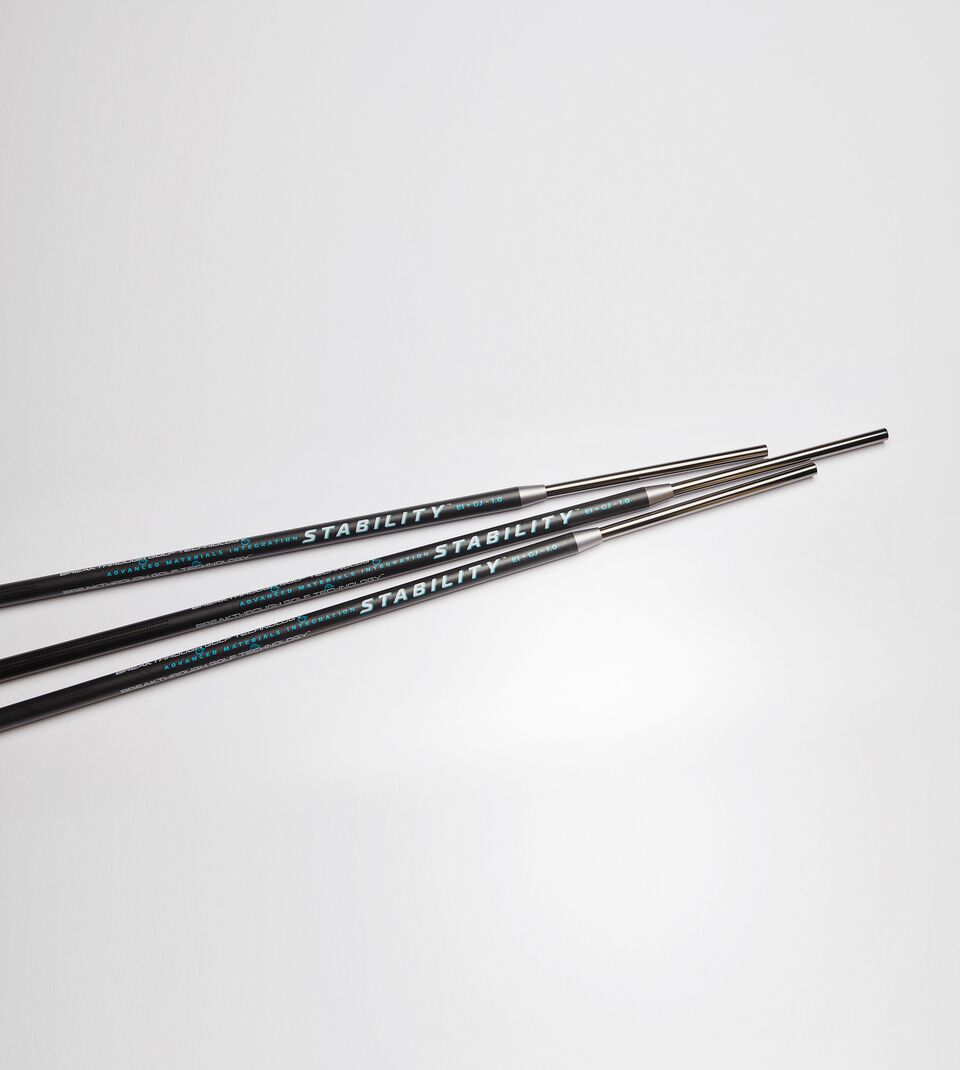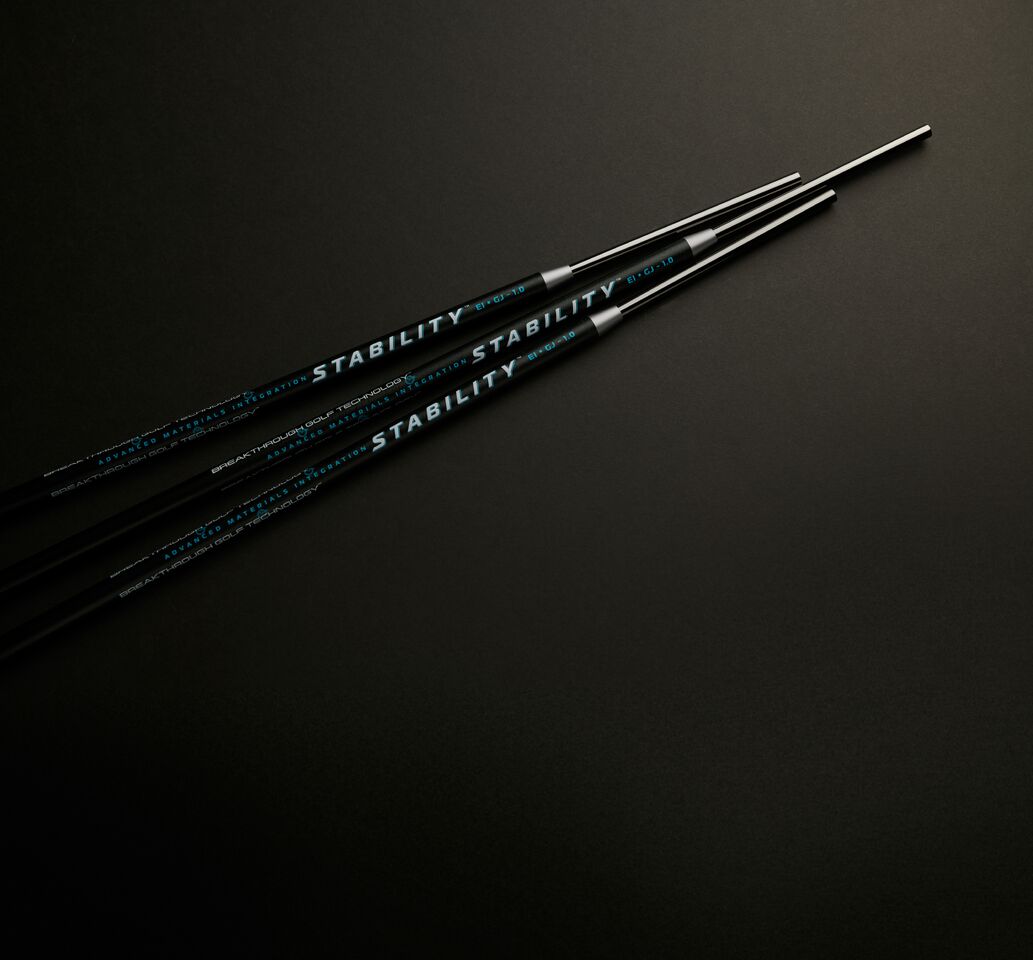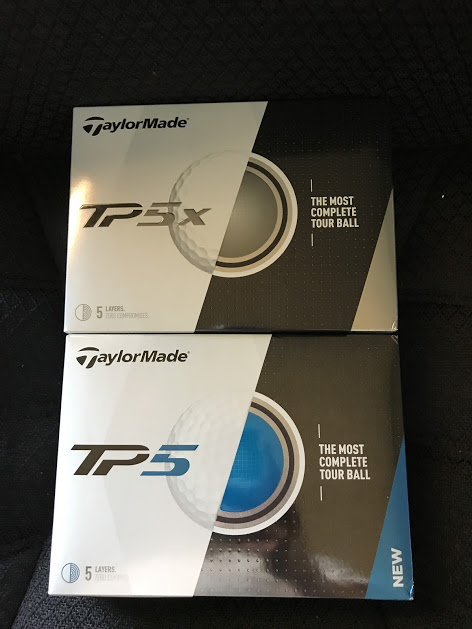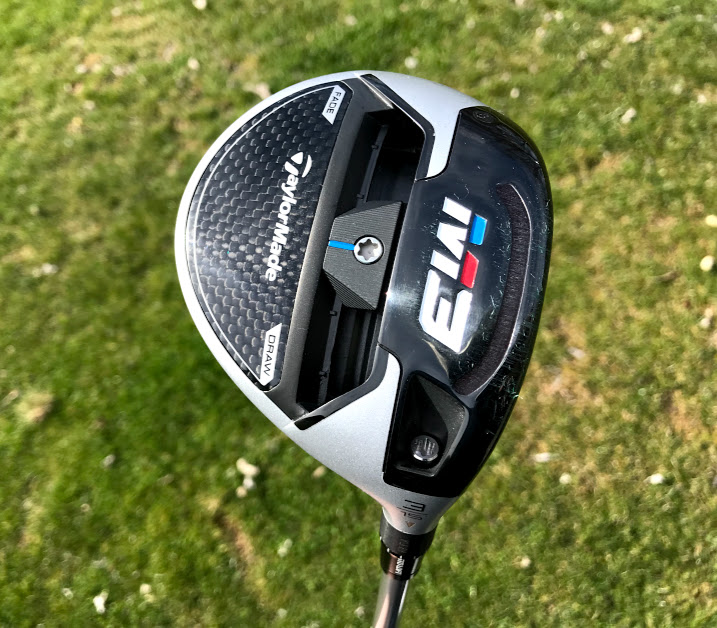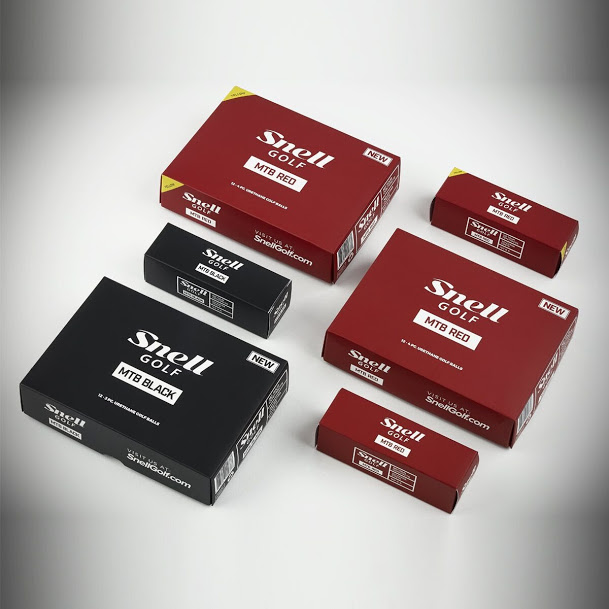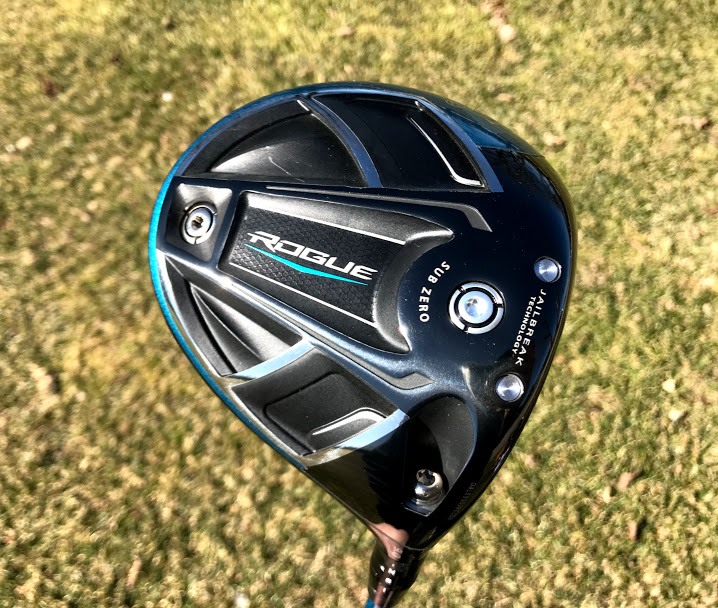Do Rapid Release Cycles Intentionally Mislead Consumers?
Do golf brands intentionally mislead consumers via their rapid release cycles? Let’s take a moment to address a dangerous mindset.
For an industry that has more competitors and moving parts than you could possibly imagine, the golf equipment industry does a fantastic job of keeping their customers informed, engaged, and coming back for more. However, the volume of products available can be overwhelming, which can confuse consumers and lead to false conclusions as we try to make sense of it all.
I’ll cover a few of these misconceptions in a series of brief posts, but I encourage you to offer your own views in the comments section below. You can also contact me via email at golfunfiltered@gmail.com.
Part 1: Do OEMs intentionally mislead consumers via rapid release cycles?
I recently received a series of messages from a reader who was absolutely convinced that golf’s biggest brands maintain equipment release cycles meant to intentionally mislead their consumers. While I vehemently disagreed with the points he argued, it was not the first time I’d heard this hypothesis, nor will it be the last.
Golf’s original equipment manufacturers (OEMs) are the brands that we all know. Any company that produces parts and equipment that can be marketed by another manufacturer falls into this category. Think Callaway, TaylorMade, PING, Srixon, Cleveland, Bridgestone, Mizuno, and others.
For years these companies have been locked in competition to find a place in your golf bag, and this has become more difficult over the last five years. I’ve argued the quality gap between one OEM to the next is more narrow today than ever before, which actually helps consumers more than it hinders. You almost can’t go wrong with anything you purchase.
In an attempt to widen this gap — at least in the perception of the consumer — many OEMs have gone the route of “more is better” in terms of releasing new equipment to the market. Release cycles have sped up considerably over the years as golf’s major brands appear to churn out new equipment at a break-neck pace.
While not entirely accurate — many OEMs operate on biennial release cycles, if not longer — the sheer volume of brands following different timelines can alter our perception. More “new stuff” is released across all brands more often, so golfers feel like they just saw a new product release last month.
While perception is reality, it’s important to remember that OEMs do not want to intentionally confuse the consumer via their release schedule. That confusion occurs when the same brand releases more than one similar product in the same calendar year, and it’s something brands must do a better job at explaining.
Callaway Golf is an example of a brand that handles this well. As Harry Arnett explained in episode 152 of the GU podcast, the 2018 release of Callaway Rogue required a detailed explanation of how it differed from the Callaway Epic line, which was released months prior. In this instance, the Rogue was not a replacement for Epic; the two lines were to co-exist as a means to cast the widest net to capture the largest scope of golfers who fall into specific equipment categories.
Did consumers catch on to this difference? It would be naive to think all golfers knew that Rogue did not “replace” Epic, but this isn’t Callaway’s fault. It’s human nature to assume the new shiny toy is “better” than the last, especially since the majority of industries follow this exact logic with their new products. I received numerous emails from readers and podcast listeners who made this abundantly clear to me.
Callaway is just one example, of course, but it’s a case that further validates there is no perfect recipe to follow when releasing new products to the public. There are far greater risks to the OEM than the consumer when release cycles speed up, as I’ve discussed in the past. Overproduction and excessive inventory are incredibly hazardous forms of waste and should be avoided at all costs.
So while no successful company intentionally misleads their consumers (even typing that sentence feels dirty, but it’s a sentiment shared with me often enough to prompt this post), brands should never overlook the reality of consumer perception regardless of planning. Properly educating customers can be more valuable than the revenue generated from a one-time sale of a new product, and can continue to pay off for years.
REVIEW: The SteadHead Golf Training Aid
The SteadHead golf training aid by R&D Golf helps you minimize one of the game’s worst swing faults.
(Interested in purchasing a SteadHead of your own? Visit rdgolf.net and use promo code GUPOD at checkout for 10% off!)
One of the most oft-used pieces of golf advice most of us have heard is to “Keep your head down!” when making contact with the ball. However, many teachers will tell you to ignore this advice as multiple swing faults can result from restricting natural movement in the swing. Instead, the better mantra is to keep your head steady.
The SteadHead golf training aid by R&D Golf was designed with the latter in mind, and it couldn’t be any simpler to use. I had the chance to test the training aid during a recent range session, and while it takes some getting used to, there is definitely something important to learn from using the SteadHead.
What is the SteadHead?
R&D Golf is a new business venture for mini-tour golfer Reed Howard, a man whose background is as interesting as his golf swing.
Fans of Moe Norman’s single-plane swing will have likely stumbled upon one of Howard’s videos on YouTube. Howard, am accomplished collegiate golfer and son to Academy Award winning director Ron Howard, exemplifies how swinging the club on a single plane can benefit your game. You just have to get used to seeing what looks to be an uncomfortable move on the ball, but its results speak for themselves.
If you watch the first few seconds of the above video you will see Howard’s swing in slow motion. Watch his head throughout the swing. What you’ll see — or rather, what you will not see — is excessive head sway or rotation. That’s the quality that Howard’s SteadHead hopes to instill in your swing.
How Does the SteadHead Work?
As you can see in Reed’s video above, using the SteadHead is incredibly simple. All you need is a baseball cap and a golf club, although the best results come from actually hitting golf balls on the range.
After clipping the SteadHead to the bill of your cap, you’ll notice the yellow diamond-shaped object directly in your line-of-sight. The trick here is to focus on the golf ball while wearing the training aid, which can be difficult at first. However, after taking a few practice swings with a wedge I was able to figure it out and realized the true benefit of using the aid.
Excessive head movement in any direction during the swing is bad news. The SteadHead provides a visual cue to give you instant feedback on how much — or how little — your head moves throughout a normal golf swing. I found this to be incredibly helpful in diagnosing my own head movement, which I am happy to report was minimal and consistent.
Who Should Buy the SteadHead Training Aid?
If you struggle with inconsistent strikes throughout your round, such as hitting the ball too thin or too fat, and you just can’t seem to figure out why, the SteadHead might be the answer.
When I am playing poorly I tend to hit the ball too thin, which obviously means I am lifting up or shallowing out my attack angle at some point in the swing. Video feedback has taught me that I have a tendency to stand up straighter at impact than at address, which will cause my head to lift.
Using the SteadHead helped me control this swing fault during my practice session. Thanks to the training aid’s design I was able to see where my head was in relation to the golf ball at address. It was easy to then keep the yellow diamond in the same location as I took my swing, which let me know how much I was moving my head.
I have no doubt that the SteadHead will help my game over the cold winter months by helping me practice sound swing mechanics without being too intrusive.
You can purchase the SteadHead for $24.99 at the R&D Golf website, www.rdgolf.net.
REVIEW: Srixon Z U85 Utility Iron
The new Srixon Z U85 utility irons offer golfers of any level more options in their long game. Read our review here.
Srixon Z U85
Take control of the course
The new Srixon Z U85 utility irons are another take on last season’s exceptional Z U65, the most played utility club on the PGA Tour. Expanding to more lofts to reach even more players of different levels, the Z U85 is another example of the greatness of this product series.
Background and Technology
The Srixon Z U85 was built for distance: there is absolutely no doubt about that. The SUP10 cup face design combined with a fully hollow clubhead construction helps you get the golf ball into the air more easily, optimizing launch and producing ball speeds you’d usually expect from a wood.
All of that distance and forgiveness is worthless if you don’t have confidence to use it. Srixon addressed this admirably by designing a club with the look of a long iron, while the club’s wide sole makes you believe you can hit it from any lie. The stock UST Recoil 95 graphite shaft has the look of steel, further instilling confidence when you look down at the club.
The success of the Z U65 gave Srixon the opportunity to expand the scope of their reach with this new iteration. You can now order the Z U85 in five different lofts, spanning from the 18° driving iron down to a 29° 6-iron. This allows you to group the Z U85 in a combo with any of the other Z Series options, making it one of the most versatile series available on the market.
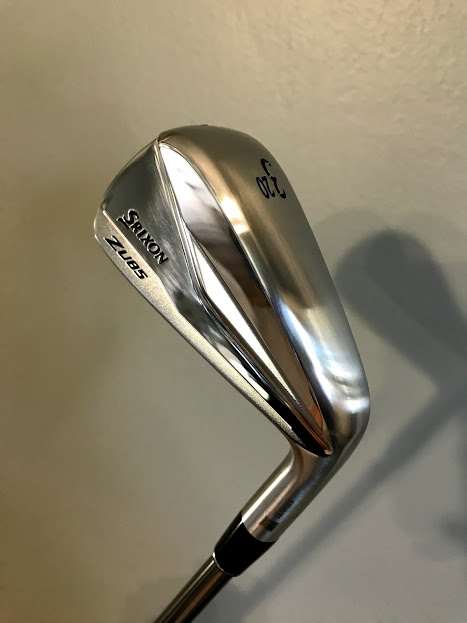
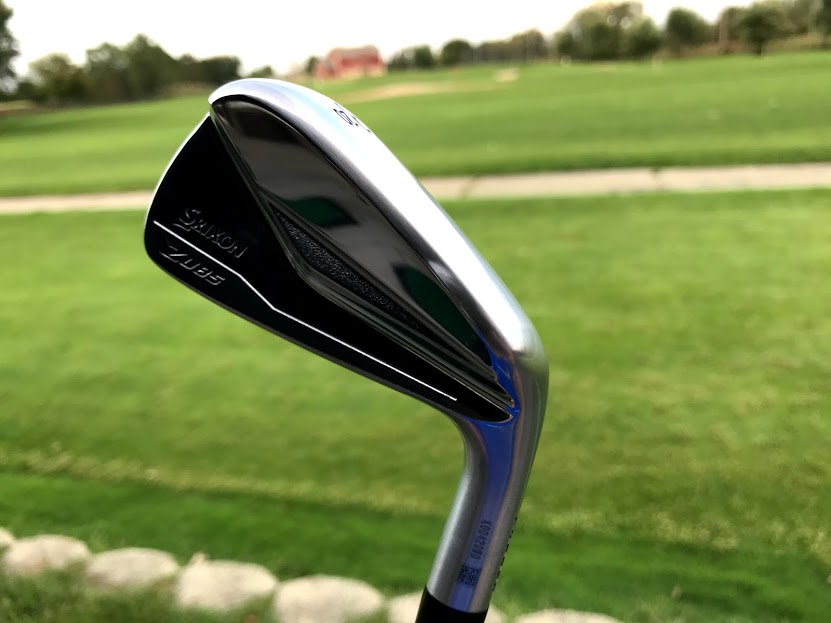

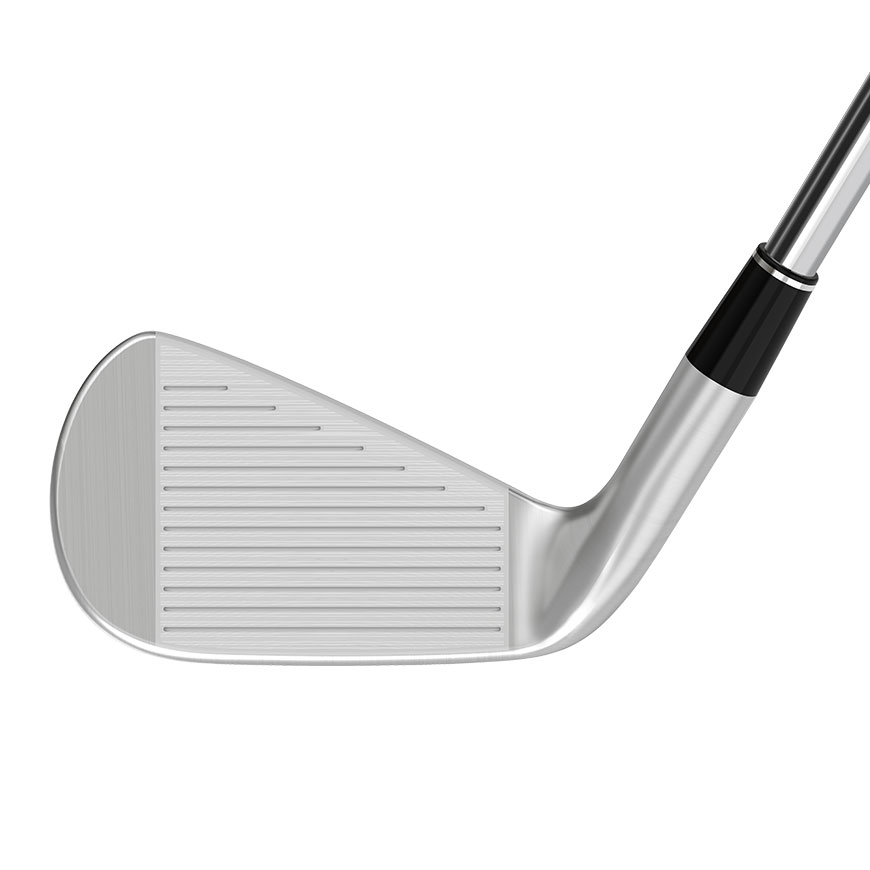

Performance and Feel
Everything about the Z U85 feels solid. You’d think the concept of a fully hollow clubhead would make it feel or sound cheap. This is not the case, of course, which is confirmed with every swing of the club.
At impact the club sounds explosive. When struck well, the Z U85 resonates like you’d expect a tour-quality product would. Better players will appreciate this detail, and higher handicap players looking to boost their confidence will as well.
I found the 20° iron to be extraordinary off the tee and fairway, making it a weapon from over 200 yards. It was also impressive from the rough, opening the door to more scoring opportunities even after a wayward tee shot. As someone who usually struggles with par 5’s, any chance to cover more yardage in less shots is a positive.
In my driving range test, the Z U85 averaged 223 yards in the air. Dispersion was very tight — four yards on average — and launch conditions were ideal for this club category (14° launch, 3300 rpm spin rate). Average ball speed exceeded 130 mph, which is testament to how powerful this iron can be.
I did have a tendency to lose the ball left on misses, especially shots off the toe. The club’s forgiving tech controlled distance loss on these shots, which can be both helpful and concerning depending on the situation. As someone who normally plays a draw with my longer clubs, more practice with the Z U85 will be needed to limit these hooks when the pressure is on.
Overall Impression
The new Srixon Z U85 iron is an incredible utility option for players of any caliber. While there is no massive jump in tech in this year’s offering compared to the previous model, its overall performance remains stellar. I have no doubt this will be another hit with better players looking to ditch their hybrids or long irons.
The Srixon Z U85 retails for $199.99.
REVIEW: Srixon Z 785 Driver
The new Srixon Z 785 driver comes to the table with a ton of expectations. Did they meet them all? Read out review here.
Srixon Z 785 Driver
Some promises are meant to be kept
The new Srixon Z 785 driver breaks onto the scene making a lot of promises. In discussions with Srixon, we were told to expect big things from their new line of metal woods. Could they deliver, and would it be noticeable among a crowded market saturated with promises?
The answer, simply, is yes.
Srixon Z 785 Driver Background and Specs
In a time when every major golf OEM preaches distance gains and improved accuracy, it should come as no surprise that some brands get lost in the noise. Srixon's Z 765 and Z 565 drivers were incredibly well made clubs, and received their fair share of accolades. However, despite the fan fare and somewhat cult following, I never saw a single Srixon driver in any playing partner's bag last season.
That's going to change with this upgrade, I promise you that.
“This driver’s faster. This driver’s longer. This driver’s better,” said PGA TOUR player Keegan Bradley. “It’s really coming off hot and straight. It’s very forgiving and the sweet spot is really big.”
“The new Z Series Woods are pretty easy to explain: they’re long,” said Srixon's Marketing Director Brian Schielke. “Longer than our past woods, and longer than the competition. Our stronger, faster titanium, combined with cup face construction is totally unique, totally different from everything out there, and it really shows up both on a launch monitor and on the course.”
Readers of this site know how PR-speak works. Every brand is going to talk up their products, get quotes from notable names, and consumers have the option of buying into the hype or ignoring the noise. It's not often, at least in my experience, for products to truly live up to that hype.
For crying out loud, Srixon is advertising that their new Z-Series drivers produce faster ball speeds than TaylorMade M3 and M4, Ping G400, and Callaway Rogue. Right on the main section of their freakin' website.
That either takes a ton of guts, or a glutton for punishment. That's a massive risk.
Guess what? They were right.
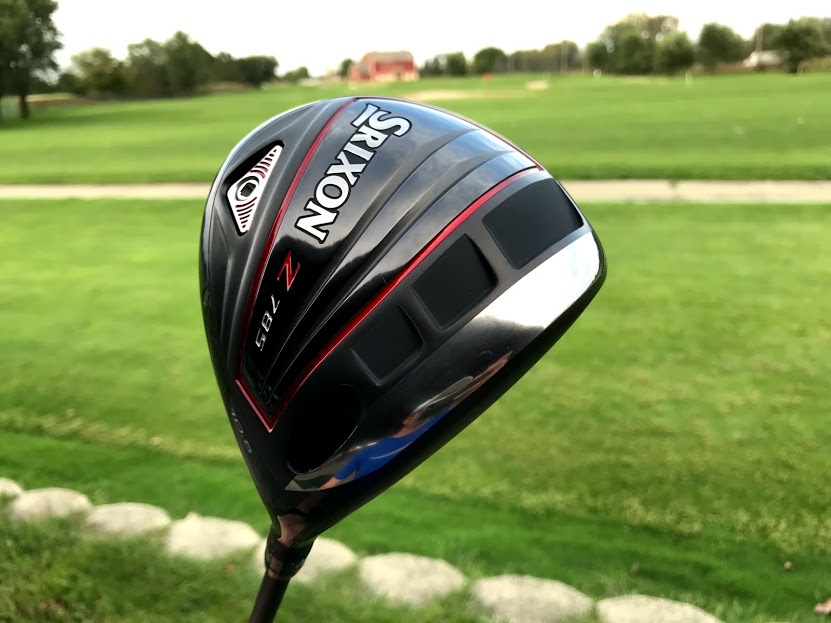

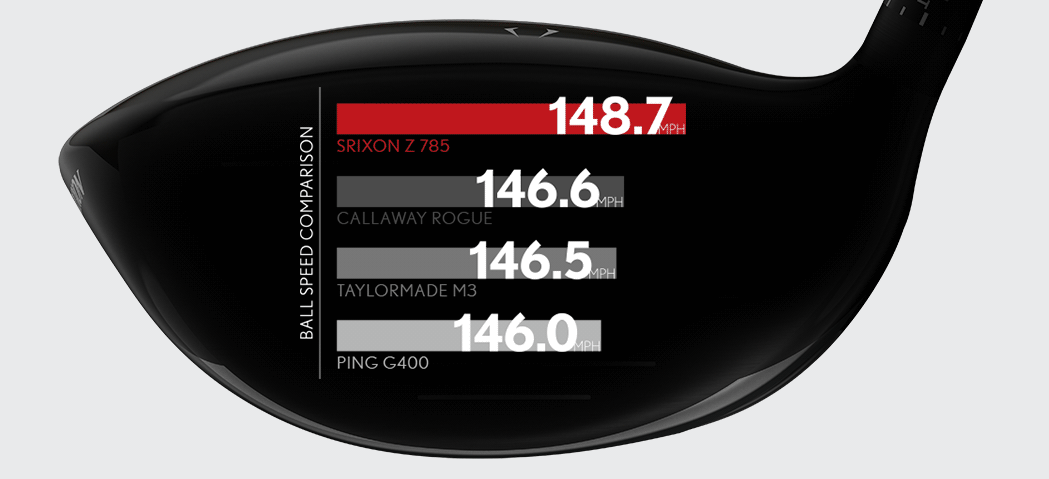
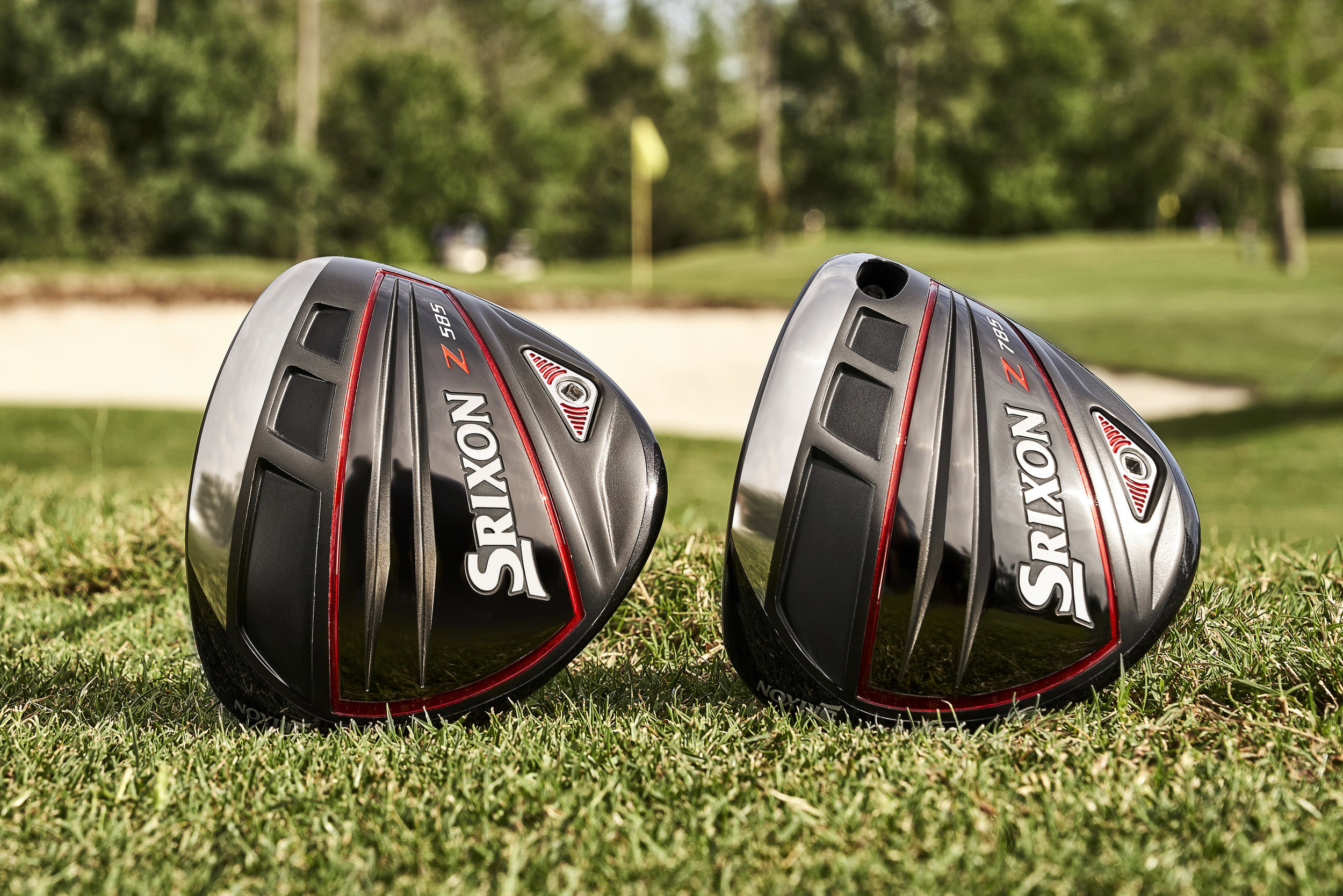
Feel, Appearance and Performance
The Srixon Z 785 driver looks like a player's club from top to bottom. The new carbon crown is similar to the look of competitor clubs, but this build allows for weight to be redistributed to key areas within the clubhead. With the muted black-grey coloring, this adds to the style considerably and maintains a look fans of Srixon will love.
The sole of the Z 785 is "flashier" than past models, adding a red hue to the outer lining of the head. This makes the club pop in appearance, which I absolutely love. Srixon prefers to stay within the traditional realm, but a little color never hurt anyone.
The real magic occurs within the clubhead. The new TI51AF Cup Face design is designed to flex more at impact, boosting ball speeds across the face. Since most mere mortals (like you and me) won't make contact on the sweet spot every drive, this feature adds to the club's overall forgiveness in terms of both speed and accuracy.
The Z 785 feels muted and soft at impact, and sound is loud but not sharp. I've always loved the crisp sound Srixon metal woods produce, and this new generation is no different. Nobody likes to draw unwanted attention on the tee due to a loud driver, and you can hear when a club is designed for better players. Such is the case with this club.
During a dry ball test in normal conditions, drives with the Z 785 averaged 270 yards with ball speeds exceeding 150 mph. Not only is this longer and faster than the Z 765 for me, it's equal to the longest drivers I've tested to date.
Thanks to the HZRDUS stock shaft in my review model, launch conditions with the Z 785 were also ideal. Initial launch came in at 16°, which is slightly below optimal (depending on who you believe). Spin was slightly higher than ideal at just over 3000 rpm, which I believe can be adjusted with a quick loft change.
Peak height was slightly higher than I would normally prefer at 35 yards on average, but this again could be due to loft setting and adjusting to different shaft characteristics. Still, distance did not suffer from this quality even if loft was left untouched.
Overall Impression
There's a lot of good to say about the Srixon Z 785 driver. Like the Z 785 irons, the golf ball jumps off the face with ease and lands in a tight dispersion near your target. Distance was incredibly impressive, especially since Srixon teased this quality for months leading up to release. There's no doubt players will be equally impressed with the club's performance, leading to more drivers in golf bags everywhere.
REVIEW: Srixon Z 785 Irons
The new Srixon Z 785 irons have the tall order of improving on the incredibly popular Z 765 series. Did they deliver? Read our review here.
Srixon Z 785 Irons
players distance, players control, incredible forgiveness
Srixon Golf's new Z 785 irons are designed for the better player looking for a boost in distance while maintaining a tight shot dispersion throughout the set. An upgrade to the previous Z 765 model, this new offering delivers on everything it says it would.
Srixon Z 785 Irons Background and Tech
It's hard to believe that Srixon can improve on the already stellar Z 765 offering from previous years, but the Z 785 does exactly that in almost every category. Before we get into the specifics, however, it's important to understand how this new series came to be.
Srixon released two updates to its popular Z Series: the Z 585 and Z 785 models. Designed with the better player in mind, the two models are complementary to one another and can be played as a combo set. This is trend that carries over from the previous generation, and an option I gamed for most of this season.
“The Z 785 and Z 585 Irons are yet another step forward for Srixon as we continue to produce
some of the highest-performing irons designed for better players,” said Jeff Brunski, Vice
President of Research and Development.
“The forged carbon steel Z 785 muscle-backs are the best feeling irons we’ve ever made,
featuring best-in-class turf interaction from the Tour V.T. Sole, and enhanced control from
deeper, sharper grooves,” said Brunski.
The V.T. Sole is another continuation from the previous generation, but that should not imply that this is the same-old-same-old. This sole design simply works from any lie condition, so why try to improve on something that's already great?
Where technology is updated is in the feel and performance of the irons. This is exemplified by the Z 785-only tour cavity, which places extra mass behind the impact area to assist with shot shaping and forgiveness better players want.
Feel and Performance
When you think of the Srixon Z-Series irons, you should immediately think of:
Soft Feel
High ball speeds
Optimal forgiveness
The Z 785 irons provide all three in spades, which shouldn't be surprising. They feel incredibly solid yet soft at impact, the ball explodes off the iron's face and shot distances remained strong even on miss hits. Despite being designed for the better player in mind, the Z 785 can be played by a wide range of handicap levels.
Distances were also impressive, even with lofts that are more on the "standard" side than other distance irons. For example, the pitching wedge comes stock at 46°, the 6-iron at 28°, and the 4-iron at 22°. Traditionalists will argue there is no such thing as "standard lofts" anymore, but it was nice to see that the pitching wedge wasn't pushing 9-iron territory.
During a dry-ball test, the 6-iron yielded an average total distance of 180 yards (long 193, short 168). Ball speed average was 114 mph, which is higher than my current gamer average. Shot dispersion was also solid as shots landed within a 12 yard circle during my test.
Most impressive, however, were the scoring clubs. For example, the 9-iron yielded shots that were 7 yards farther than my current gamer. That's almost a full club difference, which is almost reason enough to make the switch immediately in my mind.
Overall Impression
While the updated version of the Z-Series isn't mind-blowingly different from the previous generation, there is enough to make you seriously consider your options. Again, it's really damn tough to make a great thing better.
The Srixon Z 785 irons are incredibly solid, will hold their own against any competitor on the market, and will undoubtedly help you shoot lower scores. If you are looking for distance gains without playing jacked-up lofts, the Z 785 needs to be at the top of your list for purchase options.
REVIEW: Stitch Golf SL1 Stand Bag
The Stitch Golf SL1 stand bag is an incredible option for players looking to dress their game. Read our review here.
Stitch Golf is the epitome of luxury golf, offering accessories ranging from headcovers to golf bags. Their incredible SL1 stand bag is a walker's delight, and is a treat for any player who wants to dress up their game this season.
Stitch Golf SL1 Appearance and Features
Deemed "the perfect caddie bag", the SL1 weighs a mere 57 ounces and purposely limits pocket space so you're not tempted to overload it with golf balls, tees, and other junk. Constructed with Stitch's patented Touring Fabric, the look and feel of the bag's outer cover is breathtaking (and waterproof!).
Two side saddle pockets are deep enough to house a couple sleeves of balls, an extra pair of rain gloves and even a small rangefinder. Make no mistake, however: minimalism is key for this golf bag. Don't expect to carry a dozen balls in this beauty.
Two smaller pockets sit atop each saddle pocket, providing enough space to keep your car keys, cell phone and wallet. One of these is insulated and meant to carry a beverage, however I don't feel its placement is conducive to that purpose. I found both pockets to be adequate for what I needed, while a constant reminder to limit my cargo.
While apprehensive at first about the single strap design, the SL1's overall build and weight made a double strap completely unnecessary. I have no problem walking 18 with the SL1, which will be comfortable for a wide range of players. Rainy days are no issue, either, as each bag ships with a matching rain hood.
Overall Impression
While there's not usually much to say about any golf bag -- it carries your stuff, for crying out loud -- the Stitch Golf SL1 is truly in its own category.
I've been slowly adding Stitch accessories to "dress my game" like the company tagline suggests, and I have yet to be disappointed with anything I've purchased. Their headcovers are well-made, the variety of options is huge, and their golf bags are absolutely fantastic.
While the products will appeal to every golfer, their price tag may not. There is nothing inexpensive about Stitch Golf, nor should it be. The quality of their products cannot be found anywhere else, and you should expect to pay for that quality. For example, the SL1 bag retails for around $330.
Those willing to add a touch of style to their game -- and to support an independent business -- should look no further than Stitch Golf.
REVIEW: Cleveland Golf RTX 4 Wedges
The new RTX 4 wedge series by Cleveland Golf features a smaller clubhead design and upgraded tech to suit the better player. Read our review here.
Cleveland Golf's new RTX 4 wedge series brings a Tour-player upgrade in terms of look and feel to their stellar wedge options. Boasting new groove technology and four grind options, the RTX 4 is targeted specifically at the better player.
RTX 4 Technology and Background
With the release of the RTX 4, Cleveland Golf now offers wedge options to every golfer skill level possible: game-improvement players (Smart Sole), mid-to-high handicap golfers (CBX), and now mid-to-low handicap players with the RTX 4.
Featuring the fourth-generation of their Rotex groove technology, Cleveland captured voice of customer feedback from low- and Tour-caliber handicaps to design the perfect wedge for the best of the best.
“With the new RTX 4, we spared no expense in trying to achieve the best possible wedge for the best players in the world, and then bring that wedge to the consumer,” said John Rae, Vice President at Cleveland Golf. “We worked tirelessly with our tour staff to refine every detail of the wedge and its shape to fit their needs.”
In addition to an upgraded Rotex tech, the RTX 4 offers four different grind options (Full, Mid, Low, and XLOW) to customize your wedge set to the playing conditions you frequent. A more compact head shape and feel balancing exudes a strong sense of control throughout the swing, which is sure to please the world's top players.
“I mean it’s got that soft feel which is so nice,” said PGA TOUR player Graeme McDowell. “I really love the bounce profile here. I like the feeling of using the back bounce on the wedge so, when I look at that, it’s something that really appeals to me.”
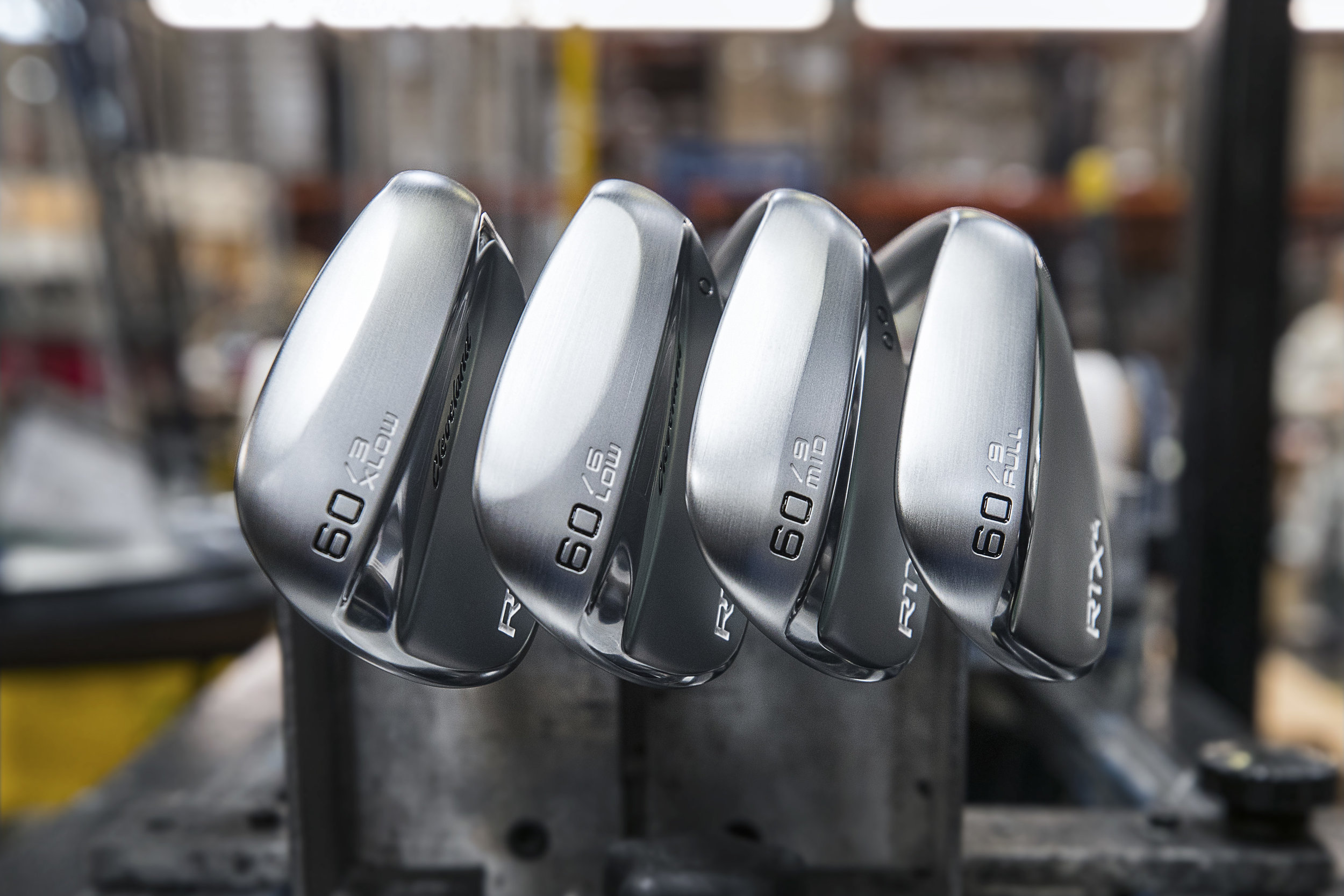
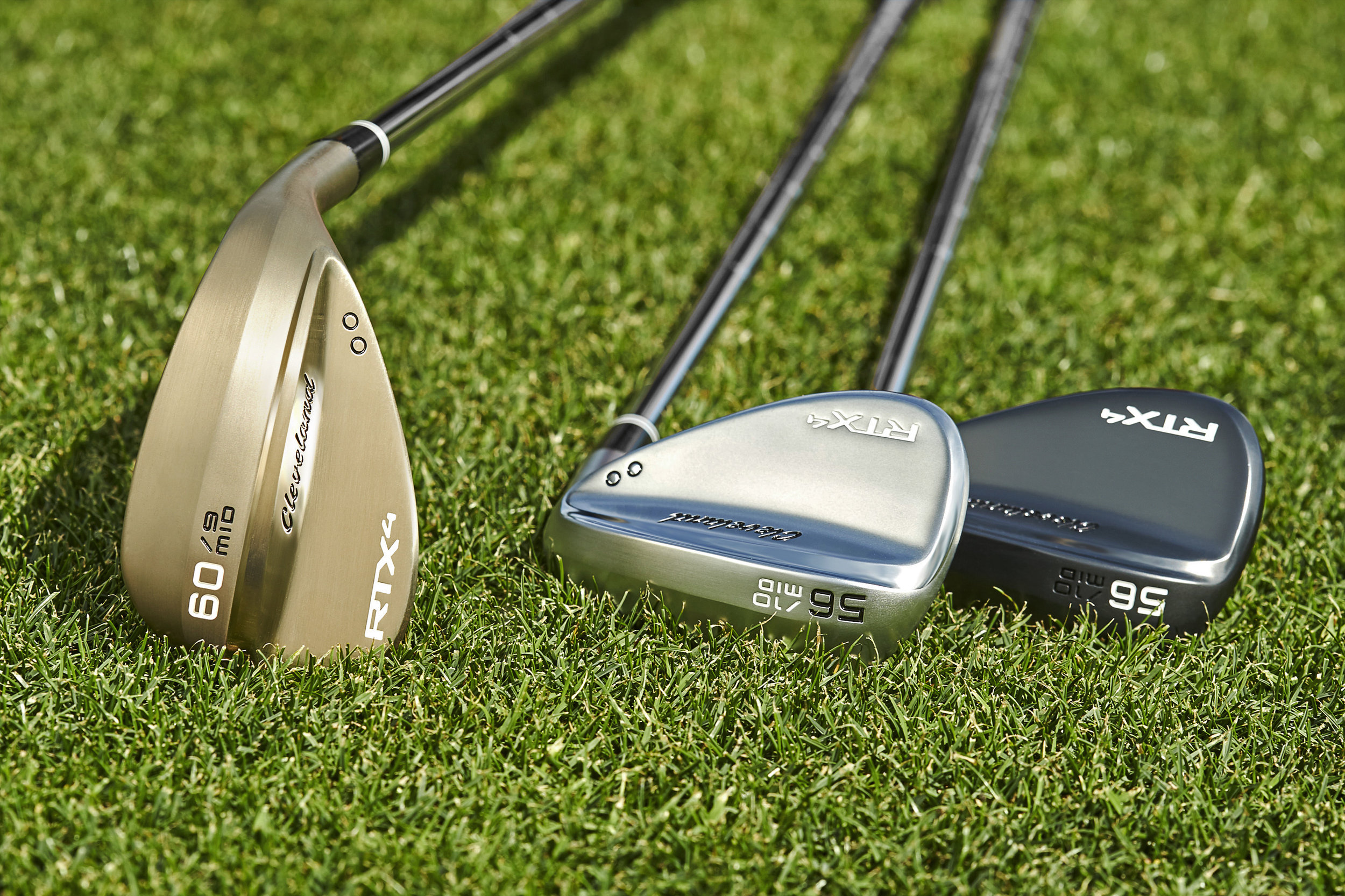
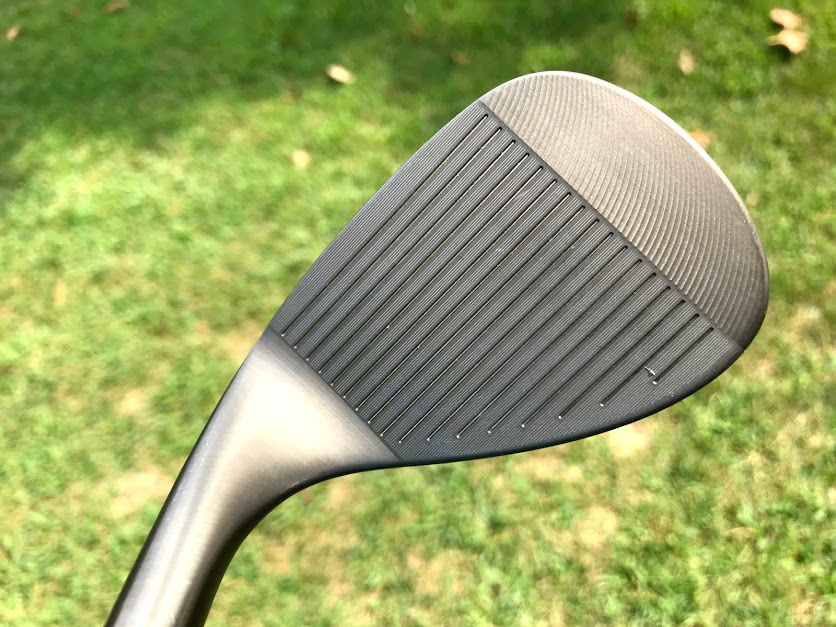
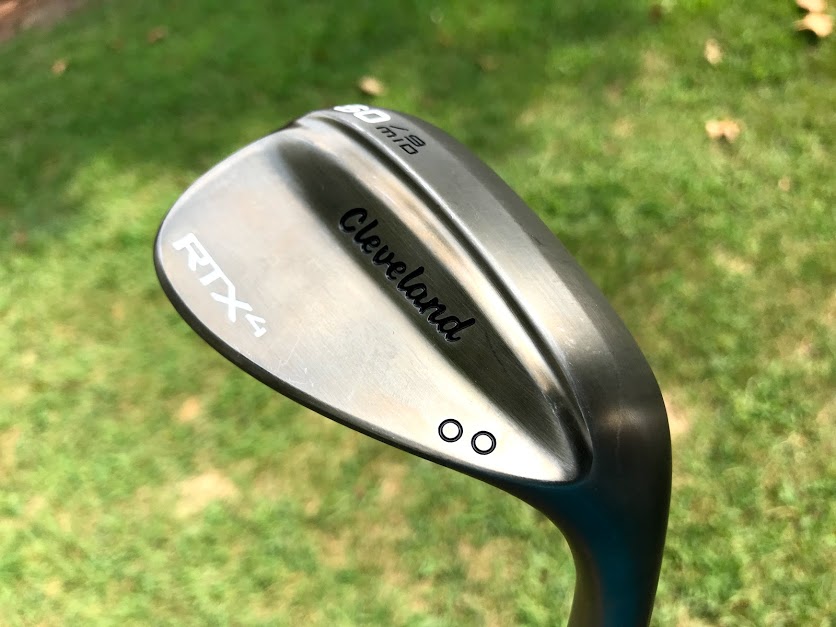
Feel and Appearance
At address, the smaller clubhead of the RTX 4 is noticeable when compared to last year's RTX 3 series. The leading edge of the wedge is subtle yet sharp, especially in the mid-grind option used in my test. I loved the look of this quality behind the ball, as I prefer a mid-bounce appearance: the wedge doesn't look like it's floating off the ground (higher bounce), nor does it look like it's destined to dig deep into the earth (low bounce).
Impact with the RTX 4 is soft and pleasant, even on off-center hits. Being a wedge designed for the better player, my hands could feel where every shot made contact on the clubface. I still believe that this quality -- which may feel harsh to some players -- is vital in understanding your impact characteristics and tendencies. The RTX 4 doesn't mess around; if you miss the center of the clubface, you'll know it.
The soft impact feel of the wedge remained consistent from the fairway, rough, and even the sand. In terms of the latter, I found the RTX 4 to glide smoothly through every bunker, even in those that were more shallow.
Each wedge emits a soft 'clicking' sound at impact, which makes you feel like you're compressing the ball just enough without feeling too heavy. I found this quality to be an upgrade when compared to last year's RTX 3.
Performance and Playability
The materials I received along with my RTX 4 wedges preached increased shot control and higher spin rates. Oddly enough, I did not notice an increase in spin during my initial test with these wedges.
When compared to the RTX 3, which I played for the majority of this season, I found the RTX 4 to spin almost 1000 RPM less on average. This was even after throwing out a few miss hits in my data with both wedges, and from different swing speeds. In fact, full wedge swings showed an increase in distance by nearly 10 yards with the RTX 4.
Don't get me wrong: if I can hit a 52° wedge into a green instead of a pitching wedge, I'll take that every day of the week. However, this will require a close look at the gapping throughout my bag to make sure my distances are optimized for scoring.
Shot dispersion was also tighter when compared to the RTX 3. My test session with the RTX 4 showed shots to be within a 4° dispersion landing zone on either side of center, which equated to less than 9 yards of dispersion total. This was substantially better than the RTX 3 for me.
Ball flight was also interesting with the RTX 4. Peak height was two yards higher than RTX 3, with a descent angle 4° shallower, which could be a result of the lower spin rates I recorded in my test. Launch showed less than a 2° between the two models.
Overall Impression
Regardless of the somewhat confusing launch monitor data I recorded in my test -- I was rather shocked to see lower spin in the new model -- the RTX 4 was impressive on the course.
At no point did I feel that I wasn't "good enough" to play this wedge design. I much prefer the more compact head, and the raw finish I chose is absolutely gorgeous. The soft feel on every shot was exactly what I like in a wedge, and shots out of the rough still stopped on the green regardless of distance.
There's no doubt I will be playing the RTX 4 wedges in my bag for the remainder of the season.
REVIEW: The Bettinardi Golf Fitting Experience | Episode 166
Adam visits Bettinardi Golf headquarters to get a tour of the facility and go through a custom putter fitting.
On this episode, Adam visits Bettinardi Golf headquarters in Tinley Park, IL and meets up with Leonard Sales, one of the company's head club fitters.
Leonard walks Adam through the Bettinardi warehouse and manufacturing process, including an exclusive behind-the-scenes look at how the company's putters are made. Afterward, Adam experiences a full custom fitting for a new putter in the famous Studio B.
Visit bettinardi.com to learn more about this incredible company and browse their excellent selection.
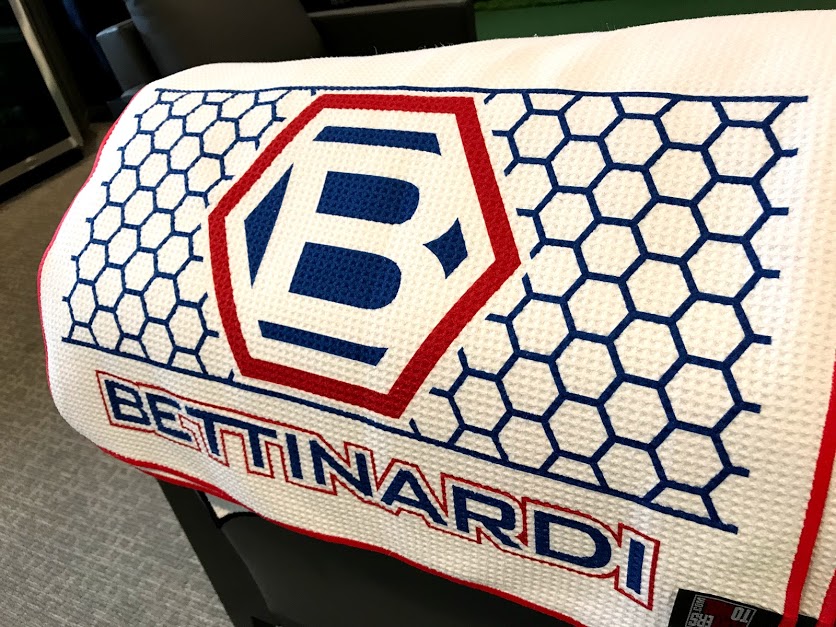

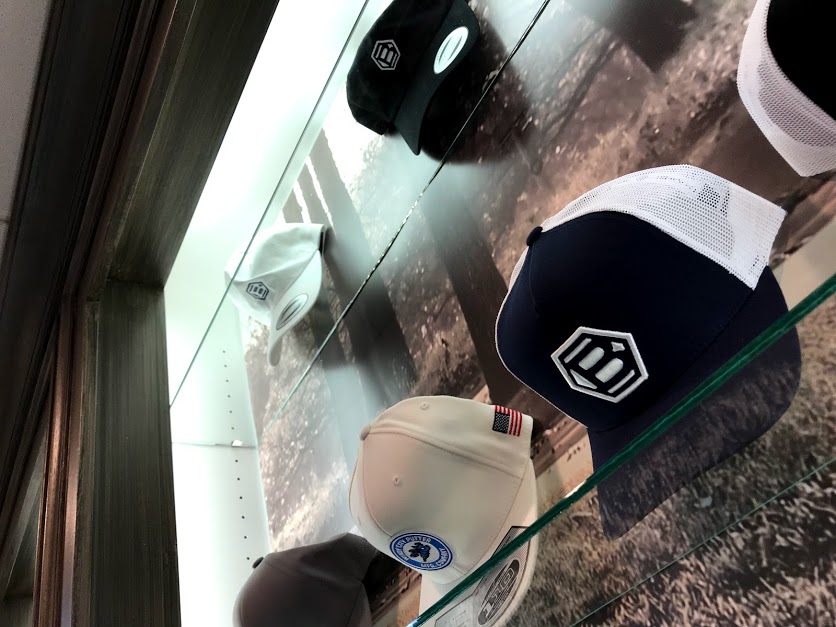
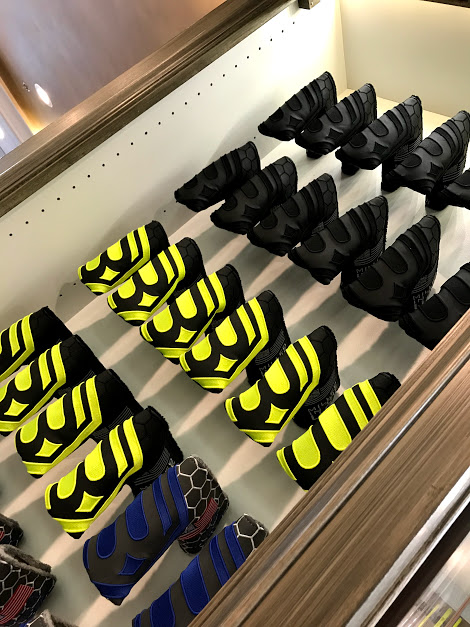

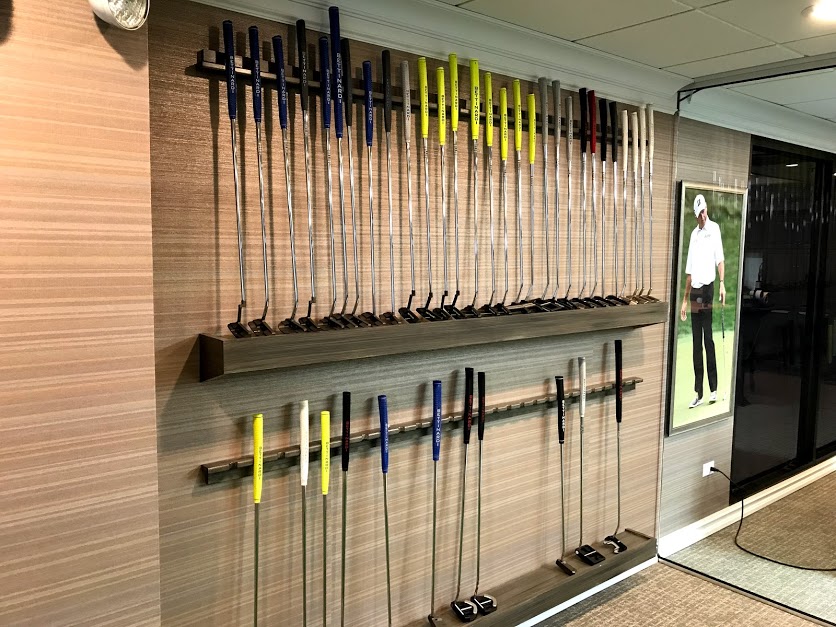
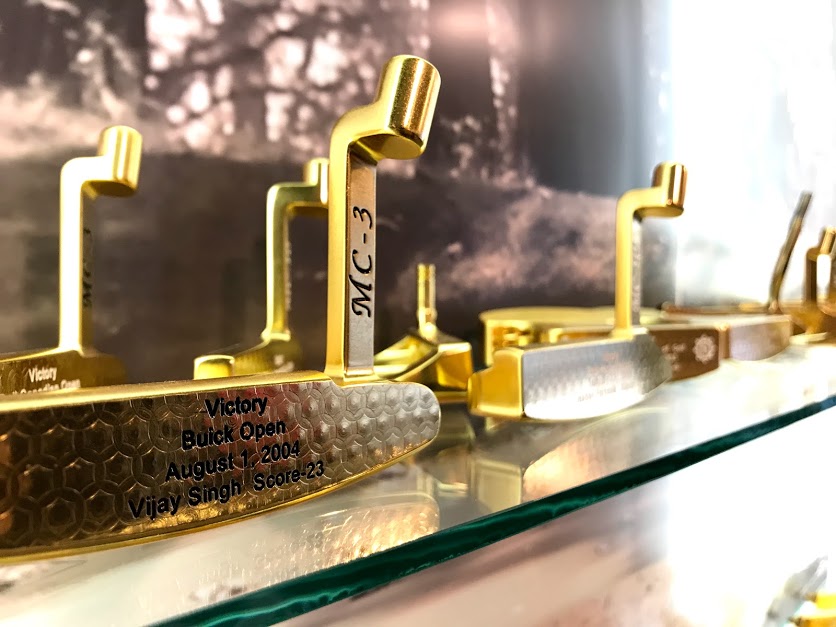


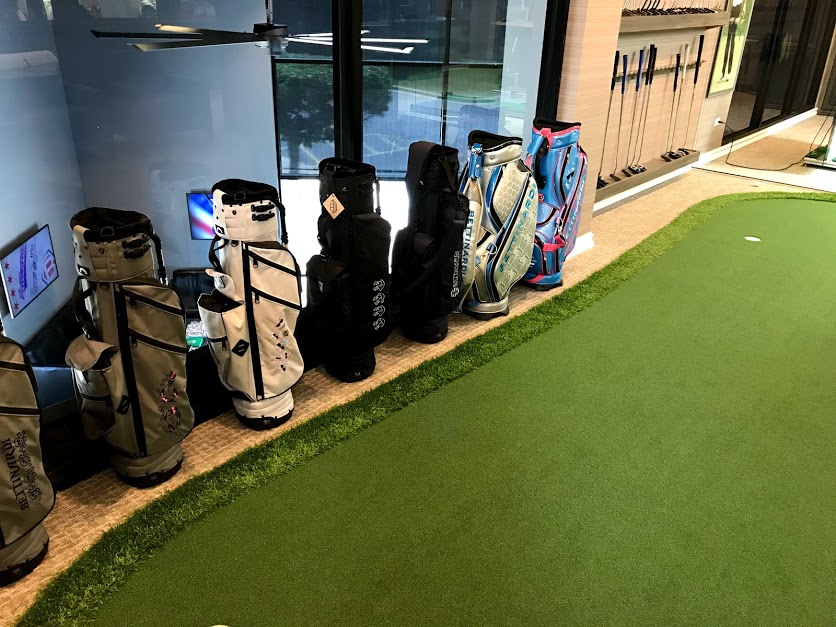
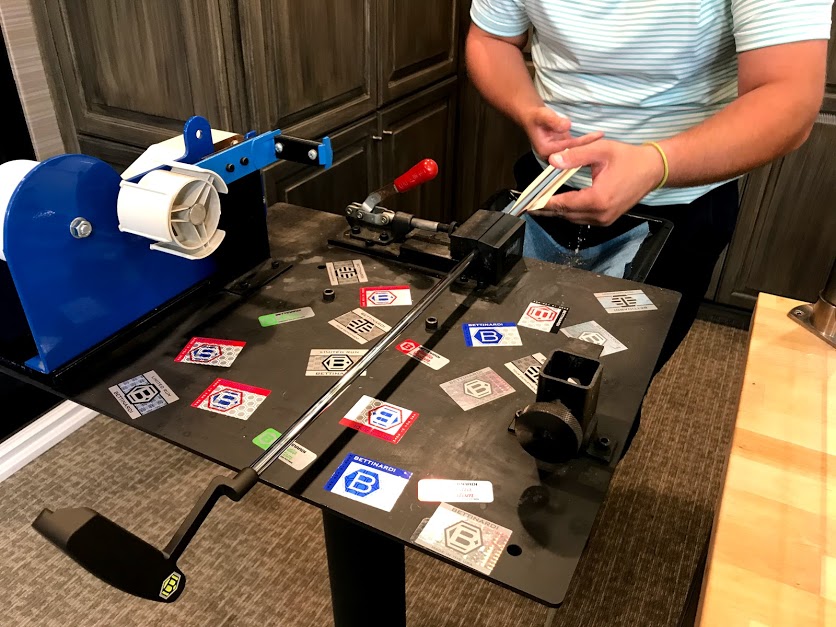



REVIEW: TaylorMade M3 Driver
The TaylorMade M3 driver is one of the best clubs we’ve ever tested. Read our review to learn why.
TaylorMade M3 Driver
One of the best drivers we've ever tested
The Taylormade M3 driver is an incredible option for players looking to boost their accuracy and confidence off the tee. Twist Face is the real deal, and distance gains result from the combination of more fairways hit and the impressive Hammerhead tech.
This is one of the best drivers I've ever hit.
M3 Technology
You've already heard the comments, read the press releases, and seen the commercials. TaylorMade Golf likes their catch phrases, and the M3 driver is ripe with buzzwords.
Twist Face is the most well-known and eye brow-raising element of the driver. A face designed to literally straighten out your miss-hits raised eyebrows across the industry and among amateur players. While the concept of bulge and roll has been around for years, seeing Twist Face in the hands of the best players on the planet across multiple tours is hard to ignore.
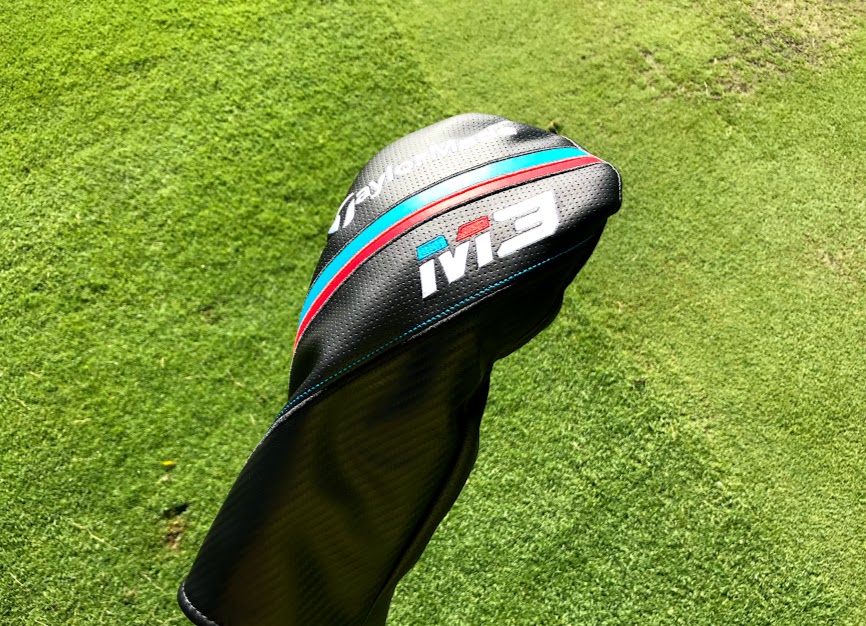
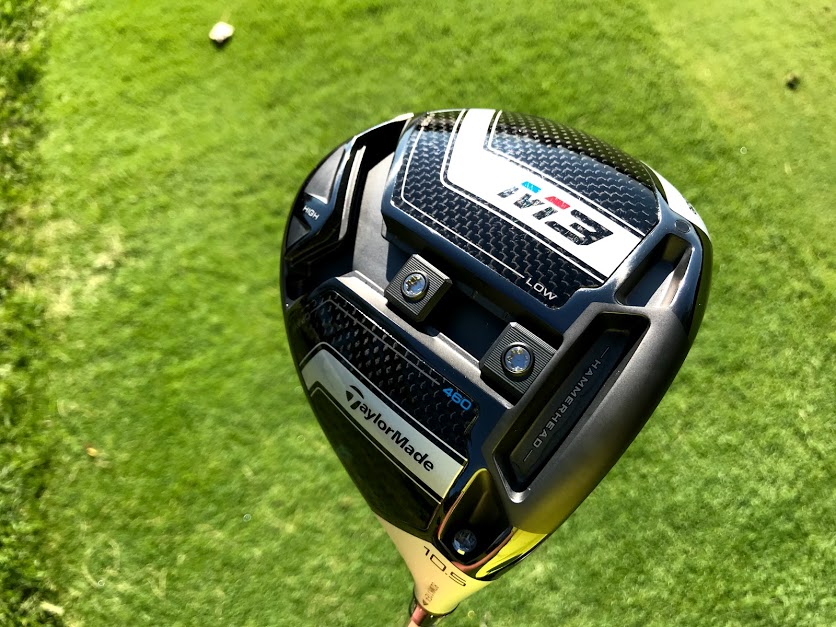
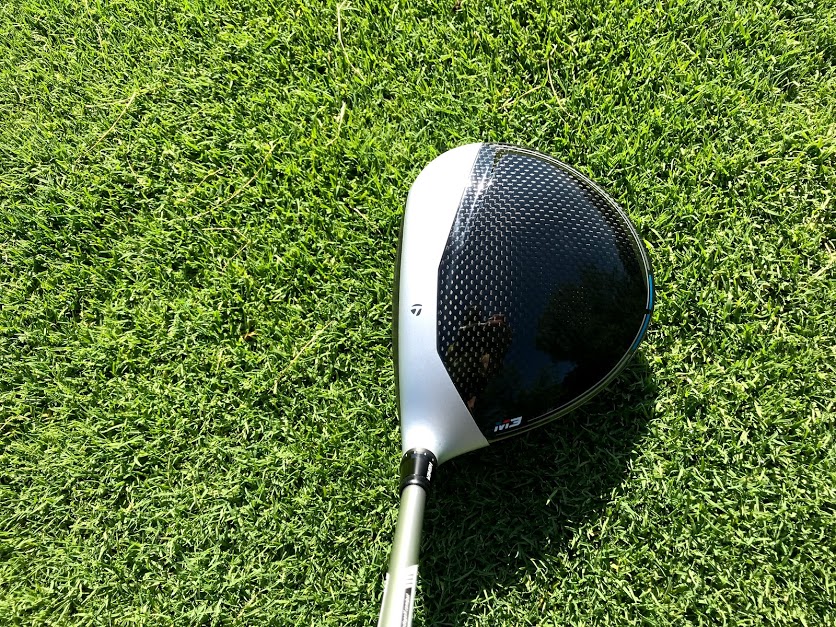
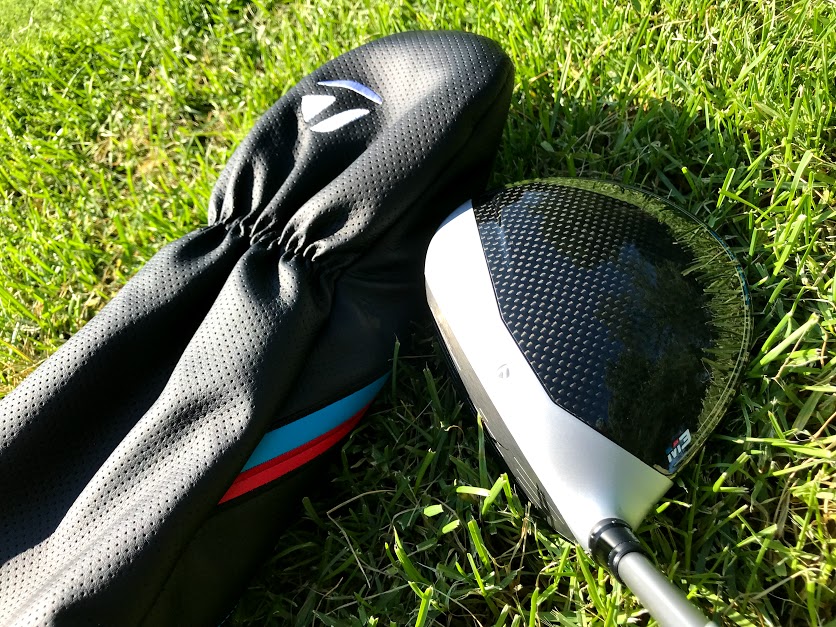
A fully adjustable hosel allows you to change lofts, and two movable weights on the M3's sole along a Y-shaped track helps you fine-tune COG, spin tendency, and shot shape if you so choose. You know the drill: get custom fit to help zero-in on your optimal settings and leave them alone.
Finally, the new Hammerhead technology in the M3 clubhead boosts ball speeds thanks to a light, flexible face that increases the club's sweet spot. Aside from sounding like another catch phrase, Hammerhead -- like Twist Face -- promises a lot.
I'm happy to report that both features keep their promise.
Performance and Feel
Much like the TaylorMade M3 fairway wood I tested earlier this season, the driver is an absolute joy to hit.
While the driver's sound at impact is a little louder and sharper than I'd prefer, it still sounds extremely solid and powerful regardless of where you make contact on the face. The ball feels as though it jumps off the face, and the thin Hammerhead face gives you instant feedback on where contact was made.
On the range, I was impressed with the ball launch monitor data I recorded with the M3. Even despite using range balls, the M3 produced distances comparable to my gamer, hovering around 245 yards of carry on average. Each ball also landed with tons of roll, bringing my average total distance to over 265 yards with limited flight balls.
What was most impressive, however, was the accuracy of the drives I was hitting. My average dispersion was at an astounding one yard offline from center as drive after drive turned back toward the fairway. Poor swings were still punished -- as they should be -- but everything would have been in play had I been on an actual course. But averages can be fickle, and numbers sometimes do not translate to reality.
So, I took the M3 on the course.
On-Course Performance
The TaylorMade M3 driver performed admirably on the course during an actual round, and what I saw on the range was repeated when every shot mattered.
On three occasions I hit drives over 300 yards with the M3, and I missed two fairways total on holes where I pulled driver. The ball simply curves back to the target line more often than any other driver I've played before, which gave me confidence to take aggressive lines on every hole.
I easily had one of my best driving performances of the year using the M3, which not only made my round more enjoyable, but also led to one of my best scores of the year.
Overall Impression
Aside from a loud impact sound, there is nothing negative to say about the TaylorMade M3 driver. Distance was outstanding in real course conditions, accuracy was at times jaw-dropping, and the clubhead was forgiving enough to keep poorly-struck drives in play.
Do you have the M3 in your golf bag? What are your thoughts on the driver? Let me know your thoughts in the comment section below.
REVIEW: Breakthrough Golf Stability Putter Shaft
The Stability Shaft by Breakthrough Golf Technology promises a more consistent putting stroke and face angle control that translates to more made putts.
The Stability Shaft by Breakthrough Golf Technology (BGT) was designed to help you make more putts by squaring the putter's face more consistently, lowering excessive vibration and noise at impact. Distance control and predictable roll is the result, making the Stability Shaft an intriguing enhancement option for your game.
Company Background and Technology
I'm going to bet that you've never thought about the shaft in your putter for more than five seconds. Why would we? You don't swing your putter like the other clubs in your bag, so factors like torque, flex, launch and weight aren't top-of-mind.
Dallas-based BGT wants to change that perception through the development of the Stability Shaft. CEO Barney Adams -- the same man who founded Adams Golf -- brings decades of engineering experience to BGT and is confident that putter shaft stability is the answer to an emerging problem in golf equipment.
As putter heads have increased in weight, the importance of counterbalancing that weight with a stable shaft has also increased. Even a small, slow putting stroke can cause the head to oscillate and twist prior to impact, which will send your putt off-line. As with most errors, this is especially true with amateur golfers.
"When I first learned about the product I knew that it could be significant,” Adams said in a press release. “It’s a step forward in golf equipment technology. What has been rewarding for me is that the Stability Shaft works better for amateurs. Pros are great putters and while the shaft does help them, it’s the inconsistency of the amateur that it corrects most.”
Eight layers of carbon fiber, a 22-gram aluminum insert, a tapered design down toward the putter head and consistent wall thickness equates to a putter shaft that is not only stable, but definitely more "involved" than stock shafts.
But does it work?
Performance and Feel
To say I was skeptical going into this review is an understatement. Not only did I question how a $199 shaft was going to help me make more putts, but how was I going to test this piece of equipment? We aren't measuring ball speed or spin rates, I'm not looking for more distance on putts, and "stability" might be the most subjective descriptor for a product ever.
But at the end of the day, if more putts are dropping, the product is performing as advertised. That's exactly what happened with the BGT Stability Shaft.
I had the shaft installed on the Odyssey EXO Rossie putter I recently reviewed this spring. A putter already optimized to get the ball rolling as soon as possible, I thought this was the best combination to see a significant -- and noticeable -- change in putts made.
The Stability Shaft felt extremely solid and soft with every putt, which was likely enhanced by the EXO's soft face insert. However, the heavier putter head seemed lighter with the new shaft, making it easier to control through the stroke. Putts absolutely stayed on line more often than my previous experience with the club, and I definitely seemed to make more putts.
Short putts within five feet were almost automatic using the Stability Shaft. There is never going to be a club that can help you make a good stroke, but I honestly felt like the putter face stayed square longer during my test. Without the appropriate lab testing equipment to show face angle data, all I can say is that the putter was extremely easy to control thanks to whatever magic the Stability Shaft provided.
Distance control on lag putts was especially impressive. The counter-weighting provided by the Stability Shaft helped me gauge speed and line easily, which can save a handful of strokes during my round.
Overall Impression
I'm not an engineer and I'm not going to pretend that I know how the Stability Shaft technology works... it just does.
Based on what my eyes told me, I made more putts more often using a putter with the Stability Shaft installed. Further testing and rounds played will validate what I saw during my test, but putts just seemed easier using this technology.
As I've said hundreds of times, the only metric that matters is score, and that will be the final judge on the BGT Stability Shaft.
REVIEW: Wilson Staff C300 Driver
The new Wilson Staff C300 driver is incredibly accurate and consistent, but how does it perform in terms of distance? Read our review here.
The new Wilson Staff C300 driver offers solid performance in an extremely forgiving clubhead. Along with a fair amount of adjustability and unique technology, the C300 is a fairway-finder that will appeal to mid- and high-handicap players.
Technology
Wilson Golf has done a great job in recent years to become a solid competitor in new club technology in a saturated space. Their lineup spans the entirety of the golf handicap spectrum, offering solid options to players of any skill level.
The Wilson Staff C300 driver is no exception to this trend. Available in three standard loft settings (9, 10.5 and 12-degrees), the C300 is built to flex more at impact, which Wilson says provides more ball speed across the clubface. This is achieved by urethane-filled Power Holes on the sole and crown of the clubhead, which "minimize contact between the body and face while providing maximum flex and an expanded sweet spot."
Said another way, the C300 face will flex more inward at impact, which results in a concept called "deflection." If you've heard of the trampoline-effect you'll understand the thought behind this concept.
wilson c300 power holes
Those little suckers are billed to do a lot of stuff, but do they actually work? We'll get there soon.
Appearance and Sound
I love the look of the C300 driver, especially its dark red coloring and minimal crown graphics.
You'd think the presence of Power Holes on the crown would be distracting, but I found them to be helpful with alignment and framing the ball at address. The small Wilson Staff shield as a sweet spot target is unneeded -- it is positioned directly between the two Power Holes -- but does not come across as redundant. Finally, the "Power Holes" lettering along the bottom of the crown could probably be omitted.
The sole of the C300 is busier, complete with three weighted screws that have become a common feature among competitors. This is where the Wilson Staff shield looks great and appropriate without looking too large or distracting. FLX Face and C300 lettering is minimal and completes the overall attractiveness of the club.
The driver is fairly loud and sharp at impact, which might be off-putting to some players. This contributes to a "harder" feel, but not to a distracting degree.
Performance
Unfortunately I did not see the distance gains in the C300 that I would have expected. However, the driver performed incredibly well in terms of dispersion, accuracy and consistency.
(Note: Click on the graphic below to expand and Back on your browser to return)
When hit well, the C300 flies as far as my current driver average, which is encouraging. The Fujikura Speeder Pro 58 shaft is lighter than I would normally play, but provided a sense of light control throughout the swing. You still have a sense of where the clubhead is despite being slightly lighter than standard, and I felt like I could rip through the ball with ease.
Despite how great the club felt, however, I just couldn't get the distance gains I wanted in this session. A slightly higher backspin RPM average (2866 mph) is one contributing factor and could be adjusted by a lower loft setting.
I was very impressed with the C300's accuracy and dispersion trends. With the exception of one sliced drive, the majority of my shots stayed within four degrees on either side of the center line, equating to a tight and consistent landing area. This is incredible, especially since I was not custom fit to this club and using stock settings.
Simply put: you will hit more fairways with the Wilson Staff C300.
Overall Impression
Wilson continues to impress with their stock offerings, especially in the C-Series irons and driver. The C300 driver didn't provide incredible distances for me in this test, but the club's forgiveness and accuracy was by far the highlight.
I see this driver being a must-try for mid- to high-handicap players who just want to see the short grass more often. Taking the C300 on the course will provide further validation, but I have little doubt my score will benefit from what is a well-designed, incredibly playable driver from one of the game's best equipment companies.
REVIEW: TaylorMade TP5 and TP5x Golf Balls
The TaylorMade TP5 and TP5x golf balls have garnered a ton of buzz over the past year. How would they perform for us? Read the review here!
The TaylorMade TP5 and TP5x golf balls are two of the most popular golf ball options on the market today. Featuring technology that includes five (!) layers to increase distance and control spin, the TP5 golf ball family performs well with every club in your bag. We recently played a round of golf using both, and our impression was very, very positive.
TaylorMade TP5 and TP5x Specifications
Golf balls are the one piece of equipment -- with the exception of tees, of course -- that any player can change the easiest and most often. The sheer volume of golf ball options is staggering, and in a world where the direct-to-consumer model is gaining traction, paying top dollar for a dozen balls is literally a hard sell.
The technology found in the TP5 and TP5x golf balls not only warrant the $45+ price tag, it almost makes them worth a few dollars more.
We're talking about a ball with five layers folks. Three of those layers comprise the Tri-Fast core of each ball, engineered to transfer energy more efficiently to maximize ball speed on full shots. The final two outermost layers assist with spin control, giving you more when you need it and less on shots you'd like to have more run-out.
In a way, the TP5 and TP5x balls are the Swiss-Army knife of golf: multiple uses for almost any playing condition or situation.
Feel and Performance
While both golf balls are designed for distance, the TP5x was a bit longer for me with a higher ball flight off the tee. I found the TP5 to hold greens more often with mid-iron shots, while both options spun nicely on shots 100-yards and in.
Both golf balls felt soft at impact off the tee, which contributed to a solid, powerful sound. This is of course a combined byproduct of the golf club itself, but I loved how these golf balls sounded like I was compressing them on every single shot. You guys know I'm a sucker for aesthetics, and I simply will not use a ball that feels or sounds like I'm hitting a rock.
What was most impressive during my golf round, however, was how well each golf ball performed in thewind. My shots tend to fly at a mid-to-high trajectory, but the TP5 and TP5x both seemed to cut through the wind like no other ball I've tested. This helped with distance on multiple shots into the breeze -- often times 15 yards fartherthan my current gamers.
Anything that can give you confidence staring down a 190-yard carry over water into the wind is a good thing, and I was confident the TP5 could get me home safely.
I did not notice considerable distance gains on calmer holes when compared to my gamers, but spin, feel, and control will be optimal in any playing condition.
Durability and Value
The outer cover of both the TP5 and TP5x feels soft to the touch, which concerned me slightly about durability. I'm not the type of player that's going to scuff up a ball with my wedges, but I am definitely the type of player that might clip a tree branch or cart path during the round.
Overall, both golf balls held up rather well throughout the round, even following a few "adventurous" shots. For example, the TP5 did scuff up slightly after a few bounces on a cart path, but not to the point where the ball was unusable. It still performed great for the remainder of the hole -- and the next when I forgot to take it out of play.
You'll definitely get your money's worth with these golf balls and shouldn't worry about durability. Just keep them on grass and you'll be fine.
Overall Impression
The TaylorMade TP5 and TP5x golf balls are definitely worth the money and deserving of the praise they've received to date. Their performance in the wind was exemplary, easily making them the best performing ball in windy conditions I've ever used.
The performance gap from one urethane golf ball to the next is narrowing. This is a great thing for golfers, but perhaps confusing for players looking to find a difference from one option to the next. Cost differences compound this confusion, often leading players to buy the "cheaper" option and hope for the best.
If you're looking for a ball that will undoubtedly hold up in any playing condition -- and you're willing to spend around $45/dozen -- look no further than the TaylorMade TP5 or TP5x. There is no doubt you'll be pleased with your choice.
REVIEW: Odyssey EXO Rossie S Putter
The new Odyssey EXO Rossie putter features upgrades to proven technology that has helped millions of golfers make more putts. Read our review here.
Odyssey Golf has long been known as the No.1 putter in golf, and their new Odyssey EXO line is testament to that designation. I had the chance to review the Odyssey EXO S putter during a round of golf recently and was extremely impressed with its performance and playability.
What's New in the Odyssey EXO Series
The folks at Odyssey simply want to help golfers make more putts. That's nothing new. If you've played the game for more than five minutes, you know that these folks put out great products year after year.
The new EXO series is a brand new take on what a putter should be, spanning everything from face construction, weighting, visuals and feel. They've taken what they learned from the success of past White Hot putters -- including technology that gets your golf ball rolling as soon as possible -- and added more forgiveness to arguably the most important club in your bag.
Yes kids: forgiveness is just as important in your putter as any other club in your arsenal. Sadly, I'd argue it's the most overlooked quality in equipment.
The result is a culmination of updates to proven technology that has helped golfers of all skill levels for years. But how will it perform?

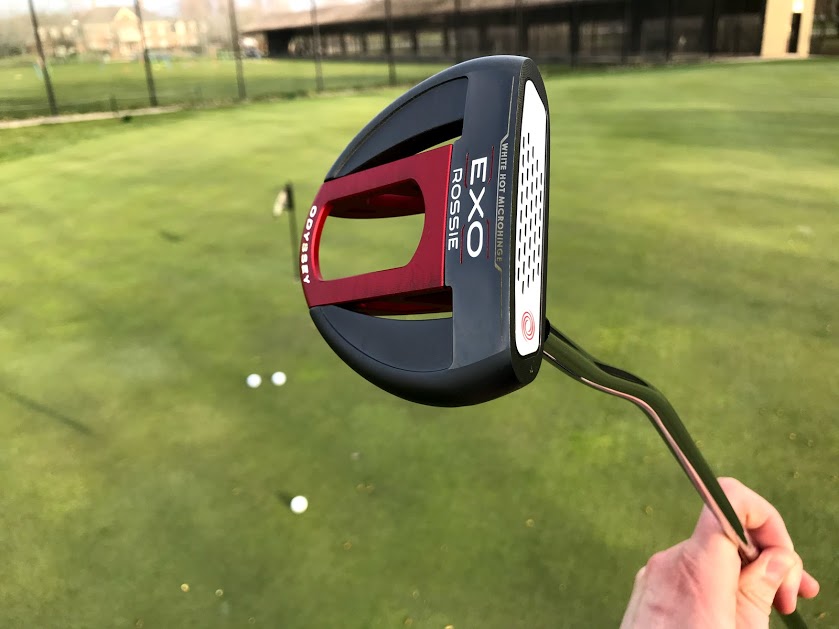

Appearance and Feel
Usually a fan of lighter blade putters, I was skeptical of how the EXO Rossie's mallet design would look at address. Too much bulk behind the golf ball is distracting; however this design was anything but.
I'm a huge fan of the open designat the back of the putter head, which makes the Rossie look smaller than it is. The grey, black and red coloring may be an acquired taste for some, but will be familiar to longtime fans of the brand. I especially loved the alignment markers on the putter's crown which frames the ball nicely and instills confident that you'll remain true to your line.
At impact the EXO Rossie feels soft, but exudes a sound that I'd attribute more to a firmer insert. It's a little odd, to be completely honest: the insert is very soft to the touch, but the ball makes a small CLICK at impact.
Weighting was absolutely perfect for my taste. The club's lower MOI and multi-material construction yields a putter that isn't too heavy nor too light, making the Goldilocks in the world smile with joy.
Performance
There's really only one metric that matters when it comes to putting: did the ball go in the hole or not?
I was pleasantly pleased with the EXO Rossie's performance on the course, especially on lag putts. While I played like hot garbage on a blustery April day in Chicago, my putting was on-point and the EXO Rossie helped me avoid a single three-putt all day.
The alignment lines took a little time to get used to -- I'm accustomed to having little to no markings whatsoever -- but in time I found them to be extremely helpful with both long and short putts.
I also noticed the ball found a true roll faster than usual for me, which helped me gauge the speed of all putts. Off-center hits seemed to lose a little speed, which is to be expected, but the roll remained true no matter where I made contact. Many a par-save putt was made thanks to these characteristics.
Overall Opinion
Players who are comfortable with using a mallet putter and who struggle with putts skidding along the green need to buy an Odyssey EXO Rossie S putter immediately. The relatively high retail price ($299) is well worth the gains you'll notice from one of the game's best putter brands.
Supreme Court Rules in Patent Case That Could Impact Golf Industry
A major Supreme Court decision on an ongoing patent case was made last week. Here is a summary of what went down and why it is important for golf.
There was an important patent law decision by the Supreme Court recently that could have implications for the golf industry, particularly startup or new equipment companies. The Supreme Court issued a ruling on the case last week, dealing with the Patent and Trademark Office’s ability to reconsider previously granted patents. Where does golf fit in to a constitutional case before the highest court in the land?
Our friend -- and patent lawyer -- Derrick Brent sent over a summary of the proceedings and impact the ruling will have on pretty much every major golf equipment manufacturer. The following is that summary as provided to us via email this weekend:
Inter Partes Review (IPR)
In 2011, Congress passed the America Invents Act, a bill changing/reforming many aspects of the patent system. One big change was the creation of a procedure called inter partes review (IPR). IPR allows the Patent and Trademark Office (PTO) to reconsider and re-determine the validity/invalidity of previously issued patent claims in certain circumstances. Anyone can challenge a particular patent and its claims, except the owner(s) of that patent.
IPRs have been controversial because of a high rate of PTO decisions invalidating challenged patent claims. Some believe IPRs are good because the PTO gets a chance to review potentially weak/faulty patents previously issued and remove them from the system, preventing costly court litigation on these patents. Others see IPRs as wasteful duplication of effort - the PTO reviewing patents it initially granted - thereby creating uncertainty for patent holders and investors in companies with patents.
Oil States v. Greene’s Energy - Supreme Court (decided 04/24/18)
Oil States sued Greene’s in federal court for using an apparatus/technology that infringed on Oil State’s patent for protecting well heads. Greene’s responded by challenging Oil States’ patent in an IPR at the PTO, parallel to the court case. The federal court issued an interpretation of Oil States’ patent claims (essentially finding them valid), while the PTO issued a ruling that Oil States’ patent claims were invalid.
Oil States appealed the PTO invalidity decision to a federal appellate court, then to the Supreme Court, challenging the constitutionality of the IPR proceeding. Oil States argued that patent rights are private rights, like property, requiring due process by a court to invalidate.
The Supreme Court ruled that the IPR is a constitutional review of a previously granted right. Court ruled that patent rights are public rights, granted by government, that can be altered or extinguished by Congress or proceeding at an Executive Branch agency (PTO).
Amicus Brief by U.S. Golf Manufacturers Council
The U.S. Golf Manufacturers Council is a golf industry trade organization, representing equipment manufacturers.
Per its member listing on its site, USGMC includes Acushnet Company, Bridgestone Golf, Callaway Golf, Cleveland Golf/Srixon, Cobra-PUMA Golf, Henry-Griffitts, Mizuno USA, PING, PowerBilt Golf, SeeMore Putter Company, STX Golf, TaylorMade-adidas Golf, True Temper Sports, Wilson (https://www.sfia.org/ industryaffairs/committees/ golfcouncil/membership)
The organization filed an amicus curiae (“friend of the court”) brief in support of Greene’s position that IPR is constitutional.
USGMC states that the golf industry has an interest in the Oil States case because equipment companies rely heavily on patents to protect technology and innovation. The industry also has an interest in ensuring good quality patents in the marketplace.
USGMC’s main position is that IPR works and is needed for an efficient patent system.
USGMC cites the fact that there have been 7000 requests for IPR submitted since it began. 66% of those requests have been granted, and 80% of granted requests going to final decision have resulted in invalidity of some or all patent claims. These final decisions have been upheld by appeals courts 80% of the time. USGMC believes this shows bad patents are being removed.
IPR is less expensive than federal court litigation - $250-330k vs $3.1M (average costs to final decision, sourced to law journal articles).
IPR establishes more fairness in the system by allowing others affected by a patent to test its validity/quality. Patent application process is between applicant and PTO, and is confidential for 18 months. IPR is a quality control check by third parties who can provide something missed by PTO.
Why Does This Matter for Golf?
The IPR issue, and USGMC’s position, should be of interest to the golf industry as a whole, but particularly to startups, smaller equipment companies, and potential new entrants (collectively “startups”) because the threat of IPRs by incumbent, larger companies could make startups’ patent portfolios less certain or risky, thus making fundraising more difficult.
Investors typically ask startups about their patent portfolios and the strength of protection. It would not make sense to invest in a product that could be copied without liability or one that could be buried by administrative review(s).
The risk of IPRs also has the potential to give larger incumbents a price advantage when negotiating acquisition of a product or patent portfolio from a smaller company.
It should be noted that many of the USGMC members are large incumbents. Cost of membership to the trade association is high - likely well out of the range for a startup. This point is not to question the integrity of USGMC, but merely to point to perspective.
The counterarguments to USGMC’s position and points
The IPR stats do not show efficiency, but rather the risk IPRs pose to patent holders. Granting 66% of requests could show a low bar or threshold in challenging a patent. An 80% chance of cancellation weighs against a patent holder fighting to the end to defend. Basically, why would a large incumbent not challenge a smaller competitor’s patent portfolio with these odds?
If the rates of cancellation are so high, isn’t the real problem on the front end of examination, not the back end? If the PTO is making so many mistakes in patent grants, then does it make sense to use them for review? Which decision is to be trusted?
Federal court litigation and IPR are two different cases and legal questions, therefore making a straight comparison of costs incongruent. Federal court lawsuits, typically, are not brought to determine the validity of a patent - they are brought to determine whether a patent was infringed. The validity of a patent in federal court is a defense for the alleged infringer - one of many legal issues in a patent infringement case. In an IPR, there is only one legal question, a challenge to patent validity - no other legal issues such as infringement. Thus, it makes sense that federal court litigation would cost more because there are more issues than just validity.
The patent application process, confidential for a period of time between applicant and office, was designed to allow newer, smaller companies a chance to build their operations so they could enter the marketplace after patent issuance. The PTO has knowledgeable examiners with access to relevant prior patents and written materials during patent process, as acknowledged by USGMC in its brief.
The purpose of this summary is not to argue for the elimination of IPR or question the validity of USGMC’s position. The purpose is to examine USGMC’s position on IPR, and the implications of that position for startups and potential new entrants in the golf market.
REVIEW: TaylorMade M3 Fairway Wood
The TaylorMade M3 fairway wood offers increased control and distance off any lie. Why did this club -- which I purchased -- win out above the rest?
Taylormade m3 fairway
ball go far
The TaylorMade M3 fairway wood is a fantastic option for any golfer looking to gain distance off the tee on tight driving holes or reach that pesky par-5 in two. While not a brand I usually play, I was incredibly impressed with the M3's performance when compared to a number of competitors.
TaylorMade M3 First Impressions
As the Chicagoland area is finally warming up (after experiencing the coldest April in 130 years), I re-evaluated the yardage gaps in my golf bag with my current setup. Noticing a considerable gap between my driver and utility driving iron -- and staring down a tee time the following day -- I realized I was in need of a new fairway wood.
Luckily, my friends at Budget Golf had all the tools I needed to make a decision on short notice. Their retail store near my hometown carries all the latest gear and club options, including that of the Big Boy Brands in golf.
I was immediately drawn to names like Srixon, Callaway, and Titleist, but then noticed the new TaylorMade M3 and M4 fairway woods. Never a fan of the white crown offerings in the past, I was very impressed with the light grey and black carbon colors that surround the clubhead. The club looks like a player's club, which accentuates the club's adjustable tech features.
The clubhead looks slim and shallow at address, which is a huge plus. I hate the look of "bulky" fairway woods when hitting off the turf, so the M3's profile was very attractive. The black clubface frames the golf ball wonderfully and assists with alignment. At first blush, the M3 was an eye-catcher. But how would it perform?
Like a kid in a candy store -- or a blogger in a golf shop -- I grabbed a few club options and headed to the testing area.
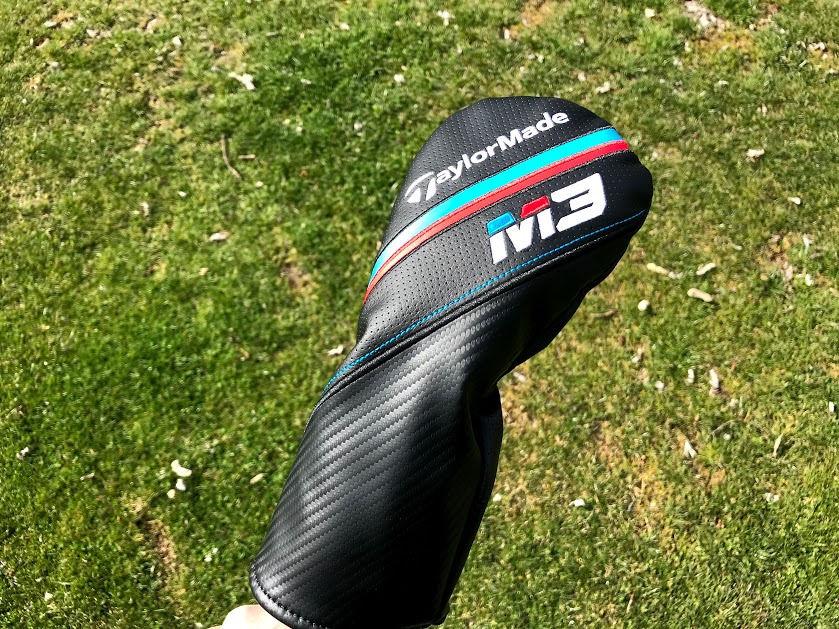
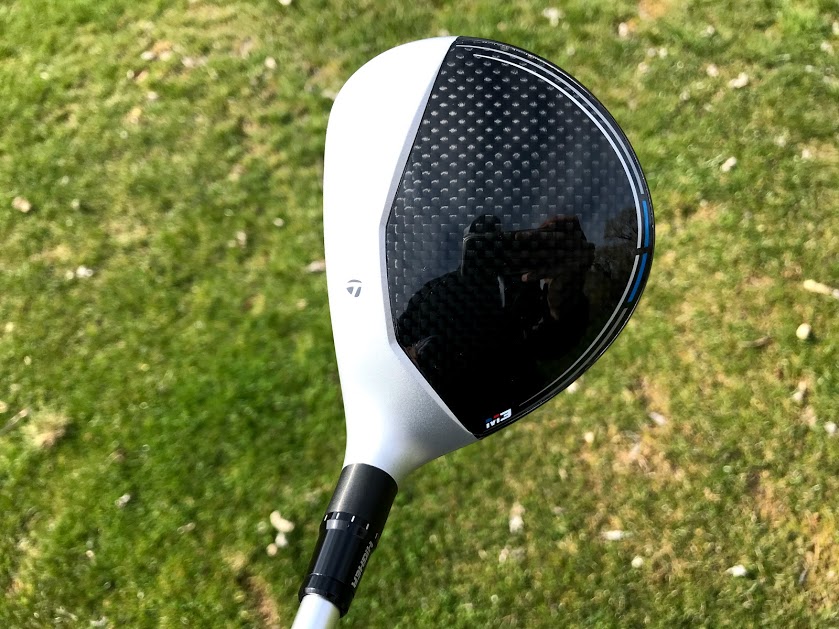
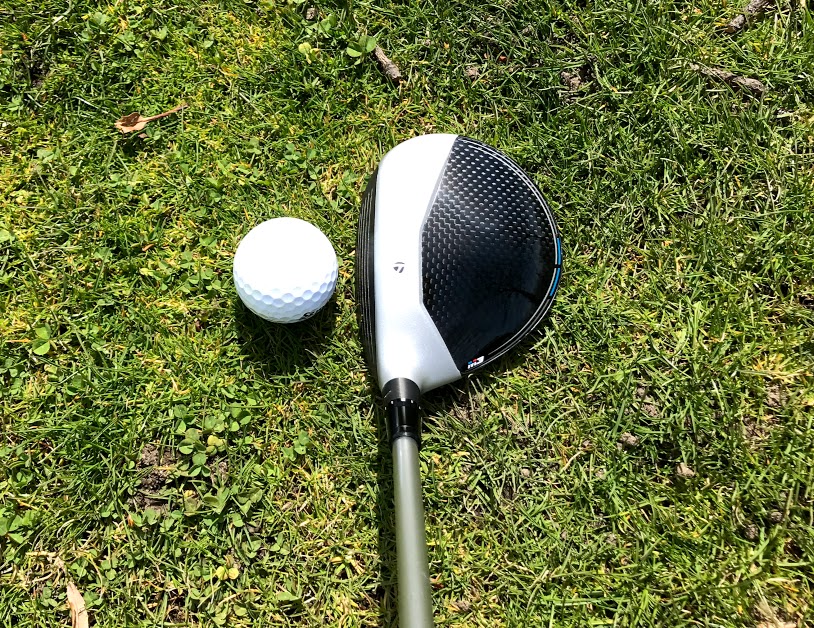
Performance and Feel
Mercy.
There's not a lot to say about the feel and performance of the TaylorMade M3 fairway wood other than "Wow."
The club exudes a solid, crisp feel at impact with a sound to match. The clubface feels thin thanks to a slightly higher-pitched impact sound than I normally prefer, but certainly not "tinny" or cheap. Instead, the sound is closer to a click that almost mimics that of an iron. Me likey.
Heading into the test I was hoping to find a club that hit the 240-yard mark consistently. The M3 produced an average of 247 yards off the turf in my first test session. While competing clubs also produced this distance on occasion, the disparity from one shot to the next was high. Not so with the M3.
Speaking of shot dispersion, the M3 produced an average of 3 yards offline during my session. Ball flight was automatic and predictable, which is exactly what you need with a club that's meant to be more accurate than a driver. Ball speed (137 mph) and backspin (2900 rpm) were also ideal for my game, punctuating the test and declaring the M3 the clear winner among the group.
Overall Impression
The TaylorMade M3 fairway wood is the real deal.
I'll admit that going into the test I had low expectations having never gamed a TaylorMade fairway in the past. The company's metalwoods have garnered a ton of attention in recent years, however, which obviously grabbed my attention. While I'm not a huge fan of adjustability in fairway woods -- sometimes more features equate to more confusion -- the tech and science inherent in the M3 is indisputable. It just works.
Readers of this blog know that I have my brand preferences when it comes to equipment. However, I'm also a golfer who appreciates data-driven performance, thus making the decision to keep the M3 in my bag an easy one.
Oh, and by the way: I purchased this club.
Have you tried the TaylorMade M3 fairway this year? What are your thoughts? Feel free to comment below!
REVIEW: Srixon Z U65 Utility Iron
The Srixon Z U65 utility iron has garnered a ton of attention in recent months, becoming the most played utility on the PGA TOUR. Read our review here.
If you have ever thought about adding a utility iron to your bag, I strongly encourage you to consider the stellar Srixon Z U65 utility. Designed to help you off the tee on tight holes or with long approach shots, there is no wonder that the Srixon Z U65 utility is the No. 1 utility club on the PGA Tour.
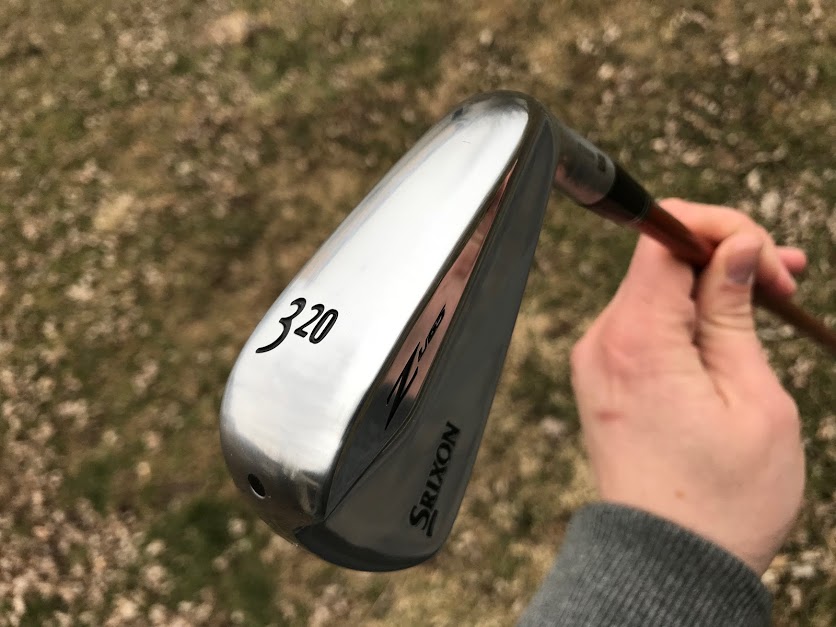
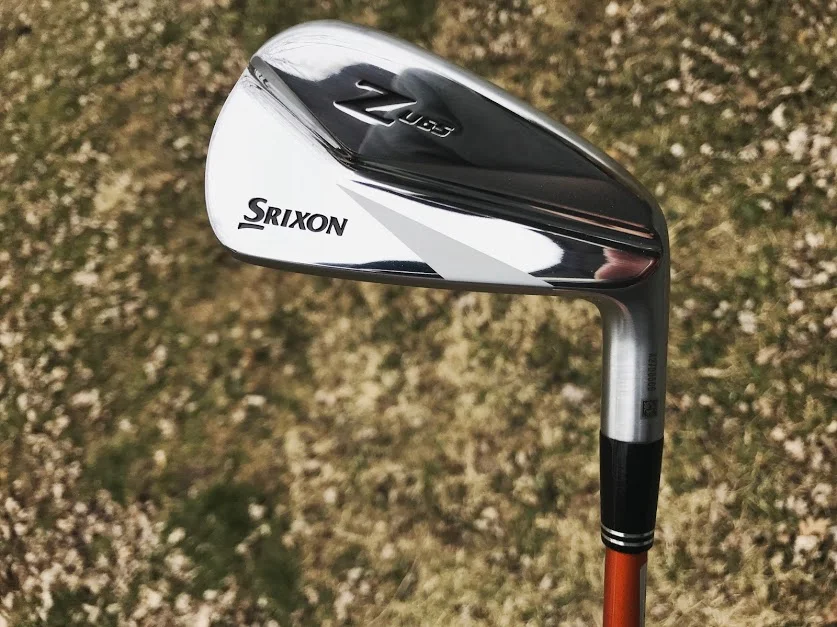
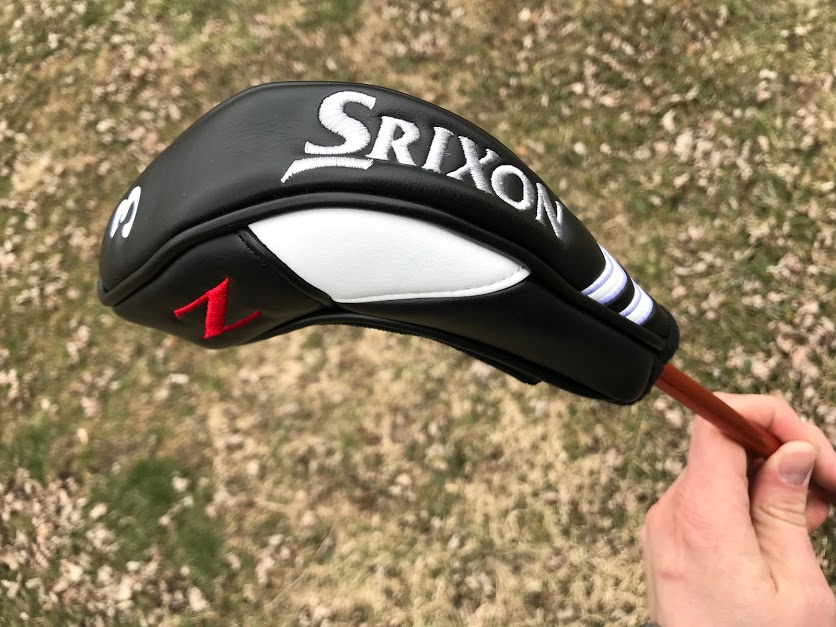
Appearance and Feel
I'll admit -- I didn't think I would prefer a utility iron to my trusted 3-hybrid. After receiving the Z U65 in the mail, however, I knew that something that looked this good deserved my attention.
The iron's design is gorgeous. The forged head features a chrome finish and clean lines that will make you fall in love. Its sole is decidedly wider than "standard" without appearing bulky. Srixon pays close attention to player feedback on multiple fronts, including the look and feel of their products. Both aspects excel in the Z U65, making it one of the best looking and feeling clubs I've ever hit.
Impact is soft, solid, and powerful. While available in steel, I prefer the feel of the Miyazaki Kaula 7 graphite shaft as it gives the iron the feel of a hybrid. This combo makes the Z U65 incredibly easy to hit from any lie.
Performance
Wow. Why in the world have I not considered a utility iron sooner?
Sooooooo I hit this 15 yards farther than my 3-hybrid. Welp.#journeytobetterpic.twitter.com/iSYXZte4sa
— Adam at GU (@GolfUnfiltered) March 25, 2018
After looking at the data from my initial range session, I was pleasantly surprised at my distance gains when compared to my hybrid gamer. Good strikes yielded nearly 15 more yards of distance than my hybrid, which suddenly changes the way I can play par-5's at my favorite courses.
Generally speaking, this iron is a monster. Spin rates are a little lower than I would have expected, contributing to a healthy amount of roll that will be beneficial off the tee. However, I can see where this might be an issue on approach shots that carry to the green. Definitely something to keep an eye on as I play this season.
(And let's be honest. How often do I carry a shot from 200+ onto the green?)
I found the increased accuracy of the Z U65 to be most beneficial as I averaged only six yards offline. This alone is an improvement from my hybrid gamer, which I have a tendency to hook.
Overall Impression
There is simply no reason why you shouldn't consider adding the Srixon Z U65 to your bag. Trust me: any doubts you had about forgiveness or distance loss in a utility iron are banished with this club. I hit it farther and straighter than any hybrid I've owned, and this iron might be my new favorite club in my bag.
REVIEW: Snell Golf MTB Black and Red Golf Balls
The new Snell Golf MTB Black and MTB Red golf balls offer upgraded features and options to the company's popular product. Read our review here.
Snell Golf has established themselves as a leader in the independent golf ball market, providing an extremely high quality product for a fraction of the cost when compared to competitors. Their new MTB Black and Red golf balls add extra flavor to their roster, each geared toward specific golfers in mind.
Snell MTB Feel
Snell's My Tour Ball (MTB) golf balls were originally released four years ago in a 3-piece premium construction to directly compete with the "Big Boys" in golf. This year, the MTB Black (3-piece) and MTB Red (4-piece) continue that trend, but with different construction profiles geared toward low-spin and high-spin players, respectively.
From a feel perspective, both golf balls registered similar to my current premium design gamers. Shots off the driver sounded solid like a premium ball should, and approach shots with my irons were similar in sound and feel. Both balls felt soft off my putter, which is a sensation that you can also feel when touching their cover.
If you were to blindfold me and tell me to differentiate between a Snell MTB and another premium brand, I doubt I'd be able to do so.
snell mtb black
Performance
I was able to take both golf balls on the course to get "real performance data" as opposed to the controlled simulator test you'll commonly see on other sites. The MTB Black is slated to offer lower spin rates than the Red, and while I didn't have my launch monitor with me on the course, I noticed drives with the Black to run out more than the Red.
The MTB Red, conversely, offers higher spin rates for players who prefer that profile. I noticed this difference the most around the greens, and especially with wedge shots from inside 100 yards. Both balls held the greens with no issues; however, the Red seemed to "grip" the turf a little better.
In terms of distance, I could not see a significant difference between the two. Both performed similar to my current gamers, with the slight edge to the MTB Black due to more roll.
snell mtb red
Durability and Value
Make no mistake about it: Snell Golf balls are designed to directly compete with the best golf balls on the market. They hold their own -- and sometimes surpass -- their competition in every way, including durability.
You'll just pay a lot less.
During my round I managed to hit a tree or two with the Snell balls. The covers on both balls did not scuff, split, or otherwise showcase any blemish after hitting a tree on the fly. In fact, had I not lost one in a creek on the back nine, I could have easily played the same golf ball for all 18 holes with no loss in performance.
Both the MTB Black and MTB Red retail for $31.99 per dozen, placing them in a category that is highly affordable for many golfers.
Overall Impression
Heading into this review I knew I would love the Snell MTB golf balls. I was not disappointed and could easily play either the MTB Black or MTB Red full-time.
My preference between the two is the MTB Red, especially with my low-spin driver. The MTB Black seemed to "drop" out of the sky more off the tee, which was something I didn't notice with the higher-spinning Red.
Nowadays it is almost silly to spend more than $35 - $40 per dozen for golf balls, unless you have a specific brand preference for no reason other than wanting to play that ball. Thanks to company like Snell Golf, you can easily find premium performance in a cheaper package.
Fallacies of the Golf Ball Distance Debate
Does the golf ball fly too far? Depending on who you ask, you will likely receive a number of different points and counterpoints as a response. Somewhere in that population of customers, however, you will also hear a number of false equivalencies, ad hominem attacks and even a few red herrings before your conversation ends. Earlier this morning golf's governing bodies -- the USGA and R&A -- released their third annual report on driving distance for everyone to peruse and debate throughout their Monday. Social media exploded as the game's numerous talking heads weighed in on a debate that has existed for years, yet has gained momentum in recent months.
Suddenly, seen in the preamble of this year's report, the conversation took an interesting turn:
“The 2015 and 2016 editions of the distance report presented the increases in driving distance since 2003 as a slow creep of around 0.2 yards per year,” the report’s preamble reads. “The 2017 data shows a deviation from this trend. The average distance gain across the seven worldwide tours was more than 3 yards since 2016."
In years past the USGA and R&A have done little more than acknowledge that golf balls are probably flying further than ever before, however have come short of suggesting anything "significant" let alone signs of a problem. The difference this year, according to them, is the fact that distance increases are being seen across multiple tours and among multiple player groups.
In other words, the data has finally gotten to a point where golf's big wigs can no longer look the other way.
Alas, those who doubt golf's growing distance issue are more than ready to rely on questionable logic to brush the concern under the proverbial rug once again.
Here are a few of my favorite arguments that I've heard on this topic. I've done my best to remain open-minded, however it might be time to try another strategy.
"Driver distances are not significantly increasing one year to the next."
This is true. Driver distances, in terms of average yardage, are not increasing by a statistically significant amount every calendar year. But that's kind of how data works when you deal with large sample sizes and averages.
According to the report, "variability in driving distance of 4 or more yards from season to season on any one tour is not uncommon." Furthermore, even though "the average driving distance on each of the men’s tours monitored was longer in 2017 than at the end of any previous season," comparing the average distance in 2016 to that of 2017 is still only comparing two data points. When over 40,000 shots is your population, it is highly unlikely to see a statistically significant difference when comparing two samples.
However, this doesn't mean distances aren't increasing as a whole. In fact, while the report suggests total distance has only increased less than 3 percent since 2003, this only tells half of the story.
Consider this data visualization from DataGolf.ca, which shows average driver distance every year on the PGA TOUR since 1983:
Something we made awhile back, fits the topic of the day....
Explore it further here: https://t.co/d3nxVBxWKM pic.twitter.com/2U3Rr50dnM
— data golf (@DataGolf) March 5, 2018
As you can see, the total distribution of players continuously shifts to the right of the graph over time, suggesting a significant increase in distance. This is obviously due to advancements in equipment over the span of 30+ years -- admittedly making this an apples vs oranges counterpoint -- however the point remains the same: everyone is hitting the ball further.
Also of note: the shift seems to "slow down" during recent years, which may explain the subtle total increase in distance referenced in the report. This is a fine example of how data scope can greatly alter your interpretation of the story.
"The longer hitters on TOUR will still out-drive the shorter hitters no matter what."
In the event of a golf ball roll back -- which the USGA has hinted at many times in the past -- another classic argument surfaces: long hitters will still pound the ball, so how does this fix anything?
Supporters of that argument are missing the point. The issue isn't that players like Dustin Johnson, Bubba Watson, Tony Finau and Rory McIlroy are hitting the ball farther than their competitors. The issue is they are dwarfing golf courses in the process.
During my recent conversation with well-known golf instructor Michael Breed, the topic of golf course architecture and golf hole design was discussed. Breed argued, like many others, that golf course playing conditions are more likely to cause greater driving distances than the golf ball itself. He's correct: hard, rolled fairways on TOUR are closer to asphalt than grass, and golf balls will roll for miles.
His recommendation to toughen up golf courses by growing rough and softening up the turf could decrease distances as a whole. However, if you support this line of thinking and are concerned with the shorter hitters on TOUR, wouldn't this shift also impact them?
It seems that rolling back the golf ball is a bad idea, however toughening up golf courses makes more sense. I don't understand that logic when everyone is still affected either way.
"Nobody is going to want to buy a limited flight golf ball."
Nobody is suggesting anybody has to.
No matter how many times it is said, some people still can't see to grasp the concept that nobody wants to take distance away from Grandpa. The professional tours are in a completely different world that the rest of us. Regular, Average Joe golfers like you and me should be allowed to play anything we damn well please as long as it makes us happy.
Manufacturers can still produce and sell any golf ball they want; however, if you are going to compete as a professional, what's the harm in playing a Pros-Only golf ball?
"Because the USGA/R&A have always standardized the rules for all golfers."
Guess what? They've also admitted bifurcation already exists between pros and amateurs, although not overtly.
I totally understand the desire to standardize rules and regulations for everyone who participates in a sport. I also understand that changing anything in the Rules of Golf often takes an act of god, however the powers that be broke this mold recently as a flurry of common sense descended upon the land.
What is preventing another adjustment to the rules, especially when every piece of equipment being produced these days wants you to hit the ball farther and data validates the trend is not stopping any time soon?
It's time to come to terms with the fact that we do not play the same game as professionals. It looks the same, you keep score the same way... but it simply is not the same game any longer.
It makes no sense to play two games by one set of rules.
What are your thoughts on this debate? Did I miss any other popular arguments you've heard? Let me know what you think in the comments below, or send me an email at golfunfiltered@gmail.com.
REVIEW: Callaway Rogue Sub Zero Driver
The Callaway Rogue Sub Zero driver promises higher ball speeds and more forgiveness than last year's Epic line, and has generated a ton of buzz in recent months.
Callaway Rogue Sub Zero Driver
The next generation of ball speed
The Callaway Rogue Sub Zero driver is an upgraded take on last year's incredibly popular Epic Sub Zero, featuring more forgiveness and the company's Jailbreak technology. My test yielded impressive results across the board, proving this driver as one of the best on the market.
Look and Feel
Simply put, the Callaway Rogue Sub Zero looks fantastic and feels the same.
The driver head design looks clean and professional with muted graphics that will appeal to a wide range of players. The club's crown includes Callaway's chevron logo as an aim point along with subtle carbon fiber graphics that fade toward the back of the club. Conversely, the club's sole looks like a spaceship hull that may be a bit extreme for some, but I felt it was tastefully done and extremely modern.
In terms of feel? Well, this club feels outstanding. Much like the Epic, the Rogue SZ sounds and feels extremely solid at impact. Jailbreak technology is the real deal and you can almost feel the clubhead's stability when you strike the ball. The Rogue's sound feedback is muted and strong, giving you a ton of confidence on the tee.
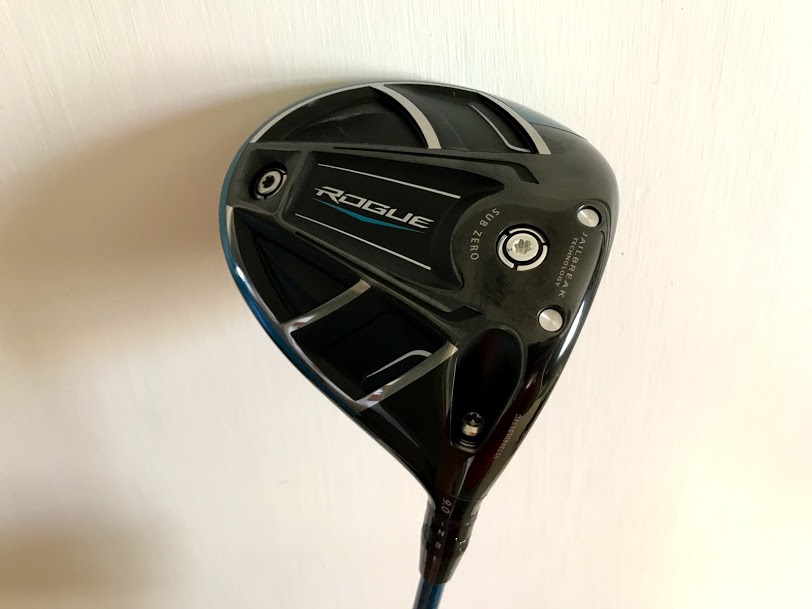
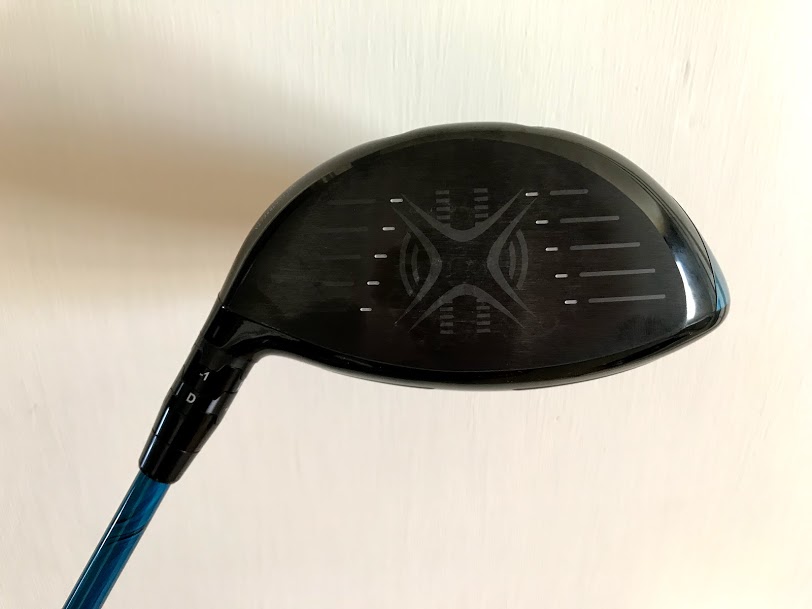
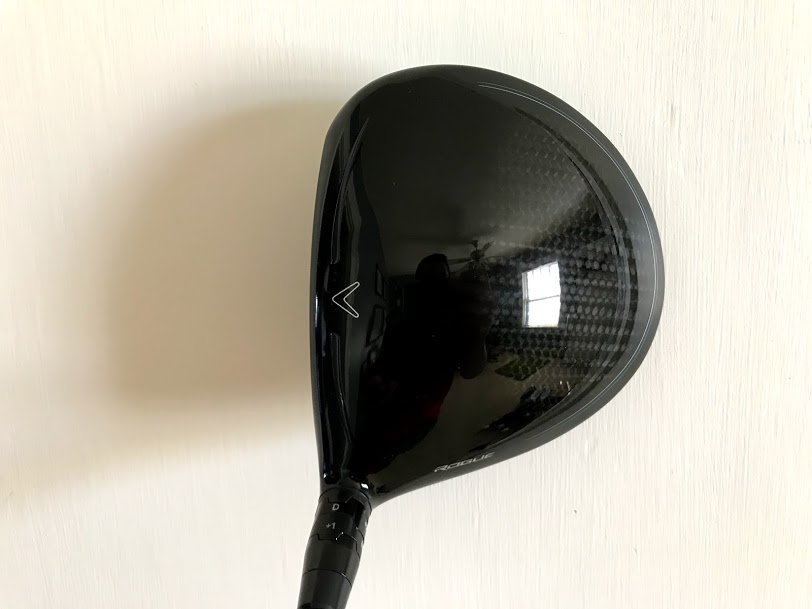

Performance
Admittedly, I was concerned that I'd like the Rogue SZ's low-spin profile. I have a love/hate relationship with the Epic SZ at times as I see spin rates as low as 1800 rpm, which can cause the ball to drop out of the sky depending on launch conditions. However, I've also hit some of the longest drives of my life with the EPIC SZ, so I was excited to see what the Rogue SZ had to offer.
Surprisingly, the Rogue did not yield spin as low as I would have expected. This is likely due to the driver weight placement toward the back of the clubhead, which can be adjusted. As a result, I was able to keep the ball in the air longer, which lead to good distance -- even with beat up driving range balls.
What was most impressive was how darn straight my drives were flying. Callaway designed the Rogue line to be more forgiving, and that is exactly what I noticed in my test. I averaged only 5 yards of dispersion off center as the golf ball seemed to gear back toward center every time. The ball also stayed in the air for over 6 seconds on average, completely dispelling my concern that the ball would fall out of the sky like a rock.
Personally, I achieved better distances with the Epic line, however I was much more accurate with the Rogue.
Overall Impression
Wow. I have to say this was a fun club to test.
Callaway is the #1 selling driver brand in the world and it's easy to see why. What they've done with Epic in 2017 will likely be surpassed by Rogue in 2018 as golfers will flock to stores to buy this club. There is no doubt players will improve their driving stats with a Rogue in their golf bag.
In closing, I should remind everyone that the Rogue line was not designed to replace the Epic. Harry Arnett recently explained this distinction on a recent podcast episode, which I highly encourage you to download to learn more.
REVIEW: GolfJet Experience
GolfJet is an upstart company that provides a luxury experience normally reserved for the game's elite. Read our review here.
If you've ever wondered what it feels like to experience the frills and benefits of playing on a professional golf tour, GolfJet gives you that chance. Based in Australia, GolfJet seeks to give members a luxury experience usually reserved for golf's elite. Whether it be brand new equipment shipped directly to your door before each new round, exclusive access to private courses, or comprehensive data reports of your game in real time, GolfJet serves as your personal brand "sponsor."
What is included in the membership?
GolfJet wants you to feel like a tour professional golfer, regardless of your skill level. The review package I received included two dozen golf balls, a brand new cabretta leather glove, and instructions on how to access their smartphone app. Also available are specialized golf tees and accessories like wool caps and microfiber golf towels. As the company is still in its infancy at this time, these features are the foundation of the membership for now.
The JET3 and JET4 golf balls
Each of the company's golf ball options feature common premium designs that will benefit players of any skill level. The JET3 (R&A approved) and JET4 (approval pending) feature 3- and 4-piece constructions, respectively. Each offer high spin rates on approach shots along with a soft feel around the green. Both boast impressive distance off the tee thanks to a low-drag 338 hex-aerodynamic dimple pattern, easily placing them in a playability category for the widest range of players.
What I found interesting, however, was the wide recommended swing speed range for the JET4 model. Typically, a golf ball model will fit neatly into a tight swing speed range as to not confuse the consumer. According to the spec sheet I received with the review package, the JET4 is "recommended for swing speeds between 50 and 100mph." That basically covers most golfers on the planet and is concerning from a performance consistency standpoint.
The GolfJet Smartphone App
My favorite element of the GolfJet membership is their intuitive smartphone app, GolfJet Connect. Golf brands are becoming more digital, so it's a great move by them to address this market head-on from the start.
The best way I can describe the app is "a country club in your pocket." You can setup a virtual "tour" to which you can invite friends to participate. The app tracks scores, handicaps, stats, and more for everyone in the tour, making the app one of the most comprehensive I've seen on the market.
Other features include an on-course GPS feature for over 28,000 courses worldwide and a robust personal stats dashboard that can be helpful in improving your game.
Overall Impression
What GolfJet is attempting to accomplish is both lofty and intriguing. Today's golfer is a more informed golfer, having dozens of golf ball options to choose from based on launch monitor readouts and custom fitting apps. Introducing a new option in this space is risky, especially with the litigious nature of the game's biggest names attempting to protect their ideas and governing bodies considering golf ball distance restrictions.
I have similar concerns for GolfJet's smartphone app. There is no shortage of free GPS apps that also feature a social networking component without the need to subscribe to a membership. Convincing the consumer to consider a membership will be GolfJet's biggest challenge, which they will hope to do by offering additional frills like exclusive access to high-end golf courses.
All of that stated, however, the GolfJet experience could catch on among the niche golfer. There will always be a market in the game for luxury experiences, and their's is one of the most intriguing models I've seen to date.
For more information, visit www.golfjet.com.



